Millennium Mills Redevelopment: Economic Evaluation, Geotechnical Issues, and Dispute Resolution
VerifiedAdded on 2023/01/12
|18
|6218
|78
AI Summary
This assignment focuses on the economic evaluation of the financing of the Millennium Mills Redevelopment project, geotechnical issues that need to be addressed, and different methods for dispute resolution. It also discusses the importance of feasibility analysis and the impact of geotechnical issues on the design and cost of the project.
Contribute Materials
Your contribution can guide someone’s learning journey. Share your
documents today.
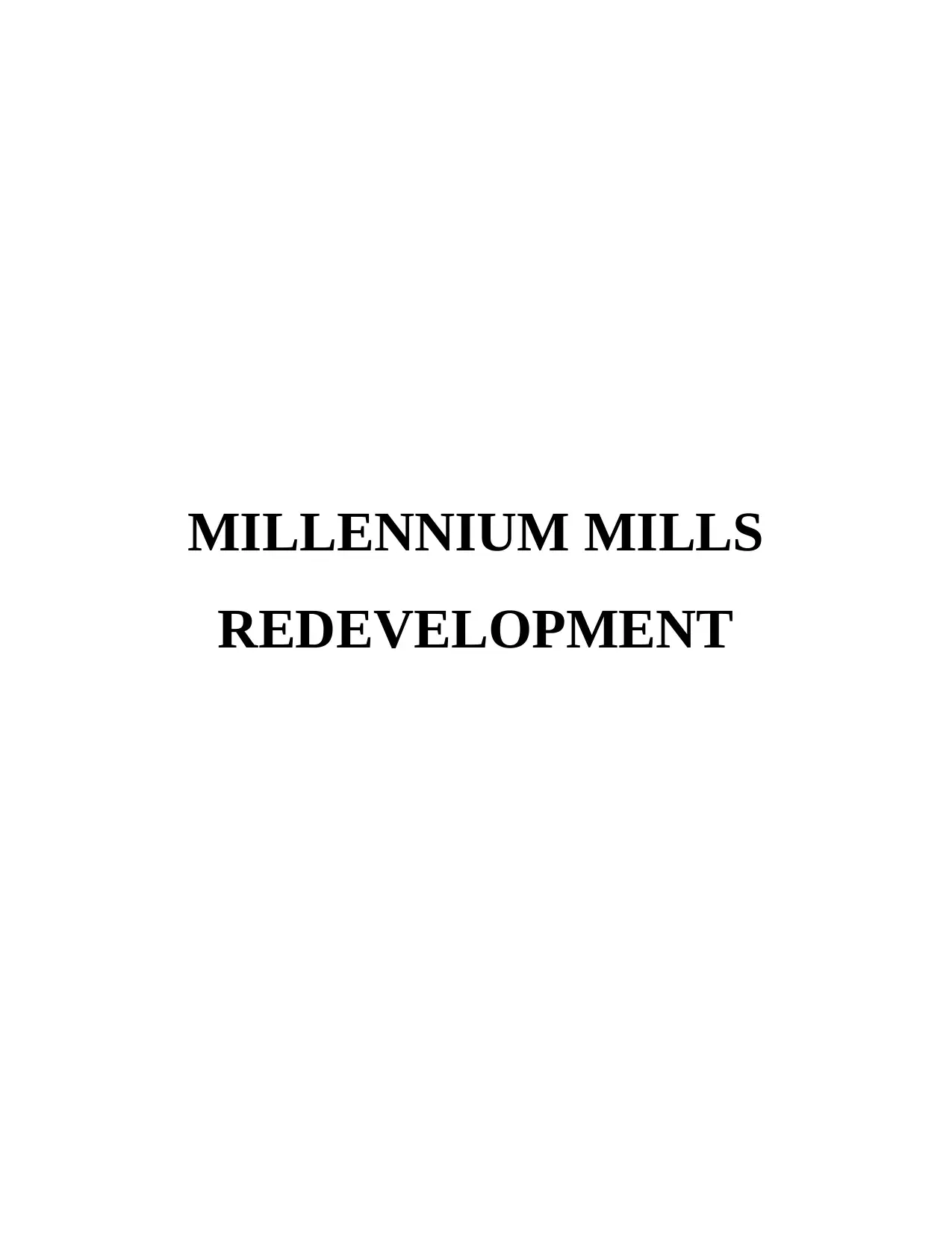
MILLENNIUM MILLS
REDEVELOPMENT
REDEVELOPMENT
Secure Best Marks with AI Grader
Need help grading? Try our AI Grader for instant feedback on your assignments.
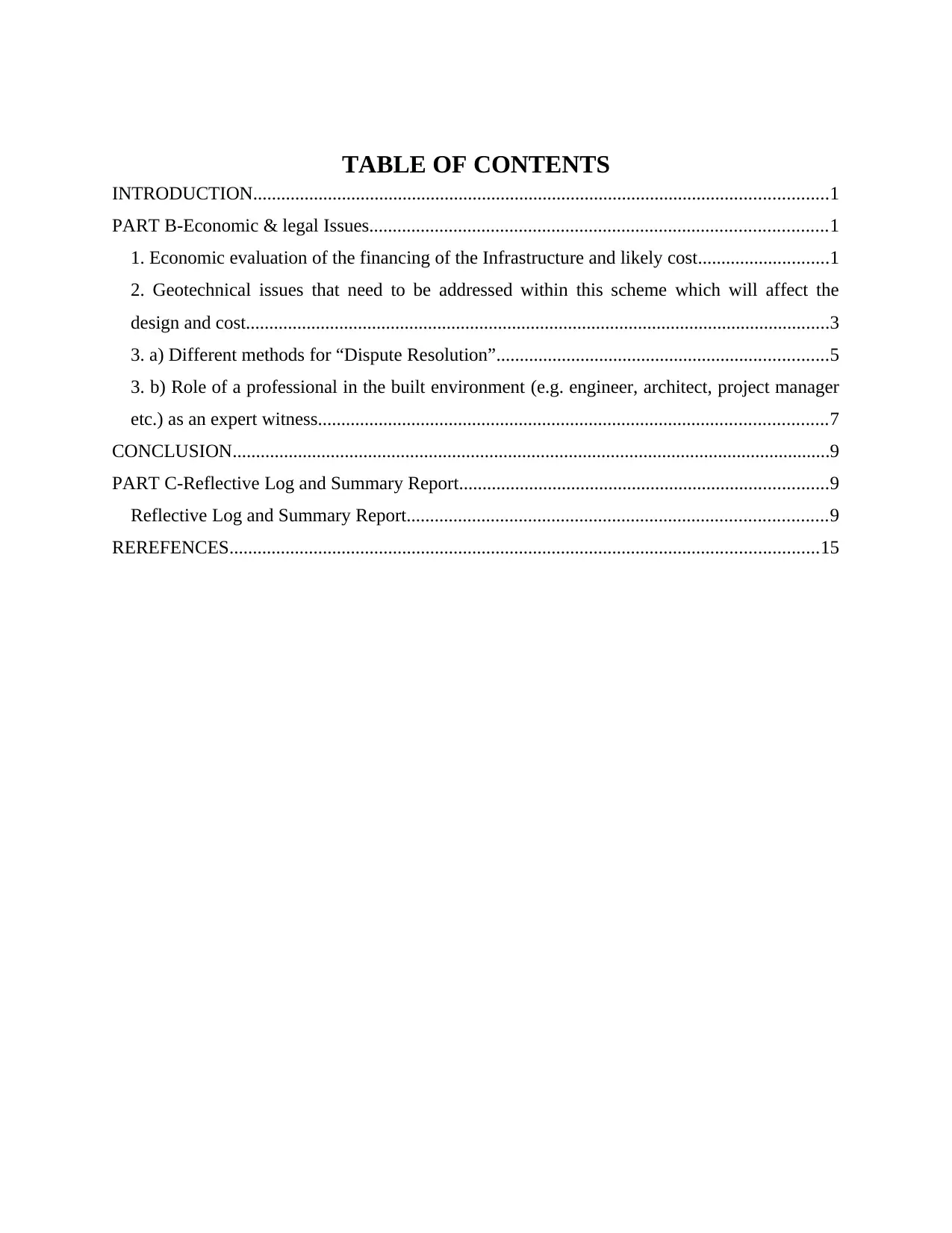
TABLE OF CONTENTS
INTRODUCTION...........................................................................................................................1
PART B-Economic & legal Issues..................................................................................................1
1. Economic evaluation of the financing of the Infrastructure and likely cost............................1
2. Geotechnical issues that need to be addressed within this scheme which will affect the
design and cost.............................................................................................................................3
3. a) Different methods for “Dispute Resolution”.......................................................................5
3. b) Role of a professional in the built environment (e.g. engineer, architect, project manager
etc.) as an expert witness.............................................................................................................7
CONCLUSION................................................................................................................................9
PART C-Reflective Log and Summary Report...............................................................................9
Reflective Log and Summary Report..........................................................................................9
REREFENCES..............................................................................................................................15
INTRODUCTION...........................................................................................................................1
PART B-Economic & legal Issues..................................................................................................1
1. Economic evaluation of the financing of the Infrastructure and likely cost............................1
2. Geotechnical issues that need to be addressed within this scheme which will affect the
design and cost.............................................................................................................................3
3. a) Different methods for “Dispute Resolution”.......................................................................5
3. b) Role of a professional in the built environment (e.g. engineer, architect, project manager
etc.) as an expert witness.............................................................................................................7
CONCLUSION................................................................................................................................9
PART C-Reflective Log and Summary Report...............................................................................9
Reflective Log and Summary Report..........................................................................................9
REREFENCES..............................................................................................................................15
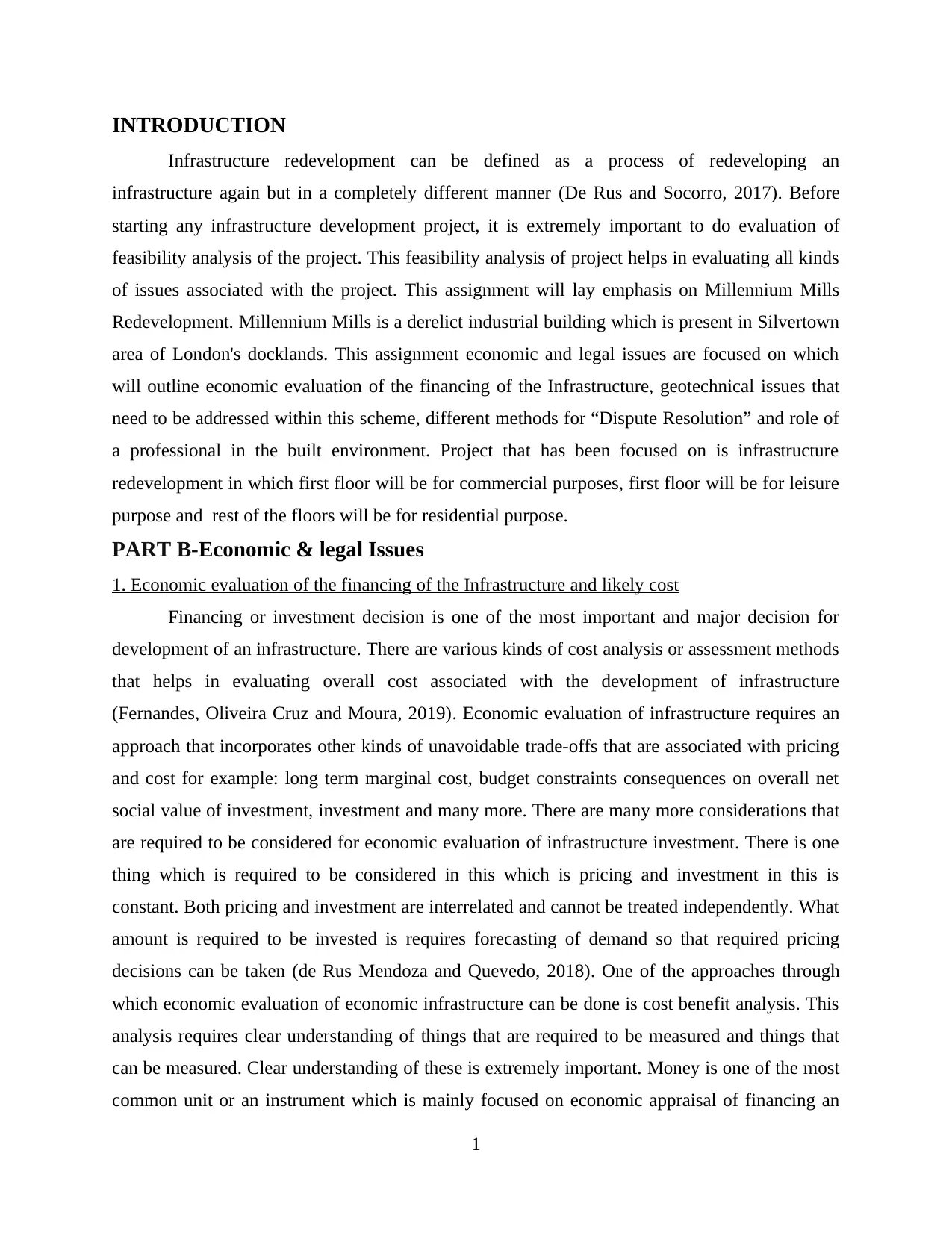
INTRODUCTION
Infrastructure redevelopment can be defined as a process of redeveloping an
infrastructure again but in a completely different manner (De Rus and Socorro, 2017). Before
starting any infrastructure development project, it is extremely important to do evaluation of
feasibility analysis of the project. This feasibility analysis of project helps in evaluating all kinds
of issues associated with the project. This assignment will lay emphasis on Millennium Mills
Redevelopment. Millennium Mills is a derelict industrial building which is present in Silvertown
area of London's docklands. This assignment economic and legal issues are focused on which
will outline economic evaluation of the financing of the Infrastructure, geotechnical issues that
need to be addressed within this scheme, different methods for “Dispute Resolution” and role of
a professional in the built environment. Project that has been focused on is infrastructure
redevelopment in which first floor will be for commercial purposes, first floor will be for leisure
purpose and rest of the floors will be for residential purpose.
PART B-Economic & legal Issues
1. Economic evaluation of the financing of the Infrastructure and likely cost
Financing or investment decision is one of the most important and major decision for
development of an infrastructure. There are various kinds of cost analysis or assessment methods
that helps in evaluating overall cost associated with the development of infrastructure
(Fernandes, Oliveira Cruz and Moura, 2019). Economic evaluation of infrastructure requires an
approach that incorporates other kinds of unavoidable trade-offs that are associated with pricing
and cost for example: long term marginal cost, budget constraints consequences on overall net
social value of investment, investment and many more. There are many more considerations that
are required to be considered for economic evaluation of infrastructure investment. There is one
thing which is required to be considered in this which is pricing and investment in this is
constant. Both pricing and investment are interrelated and cannot be treated independently. What
amount is required to be invested is requires forecasting of demand so that required pricing
decisions can be taken (de Rus Mendoza and Quevedo, 2018). One of the approaches through
which economic evaluation of economic infrastructure can be done is cost benefit analysis. This
analysis requires clear understanding of things that are required to be measured and things that
can be measured. Clear understanding of these is extremely important. Money is one of the most
common unit or an instrument which is mainly focused on economic appraisal of financing an
1
Infrastructure redevelopment can be defined as a process of redeveloping an
infrastructure again but in a completely different manner (De Rus and Socorro, 2017). Before
starting any infrastructure development project, it is extremely important to do evaluation of
feasibility analysis of the project. This feasibility analysis of project helps in evaluating all kinds
of issues associated with the project. This assignment will lay emphasis on Millennium Mills
Redevelopment. Millennium Mills is a derelict industrial building which is present in Silvertown
area of London's docklands. This assignment economic and legal issues are focused on which
will outline economic evaluation of the financing of the Infrastructure, geotechnical issues that
need to be addressed within this scheme, different methods for “Dispute Resolution” and role of
a professional in the built environment. Project that has been focused on is infrastructure
redevelopment in which first floor will be for commercial purposes, first floor will be for leisure
purpose and rest of the floors will be for residential purpose.
PART B-Economic & legal Issues
1. Economic evaluation of the financing of the Infrastructure and likely cost
Financing or investment decision is one of the most important and major decision for
development of an infrastructure. There are various kinds of cost analysis or assessment methods
that helps in evaluating overall cost associated with the development of infrastructure
(Fernandes, Oliveira Cruz and Moura, 2019). Economic evaluation of infrastructure requires an
approach that incorporates other kinds of unavoidable trade-offs that are associated with pricing
and cost for example: long term marginal cost, budget constraints consequences on overall net
social value of investment, investment and many more. There are many more considerations that
are required to be considered for economic evaluation of infrastructure investment. There is one
thing which is required to be considered in this which is pricing and investment in this is
constant. Both pricing and investment are interrelated and cannot be treated independently. What
amount is required to be invested is requires forecasting of demand so that required pricing
decisions can be taken (de Rus Mendoza and Quevedo, 2018). One of the approaches through
which economic evaluation of economic infrastructure can be done is cost benefit analysis. This
analysis requires clear understanding of things that are required to be measured and things that
can be measured. Clear understanding of these is extremely important. Money is one of the most
common unit or an instrument which is mainly focused on economic appraisal of financing an
1
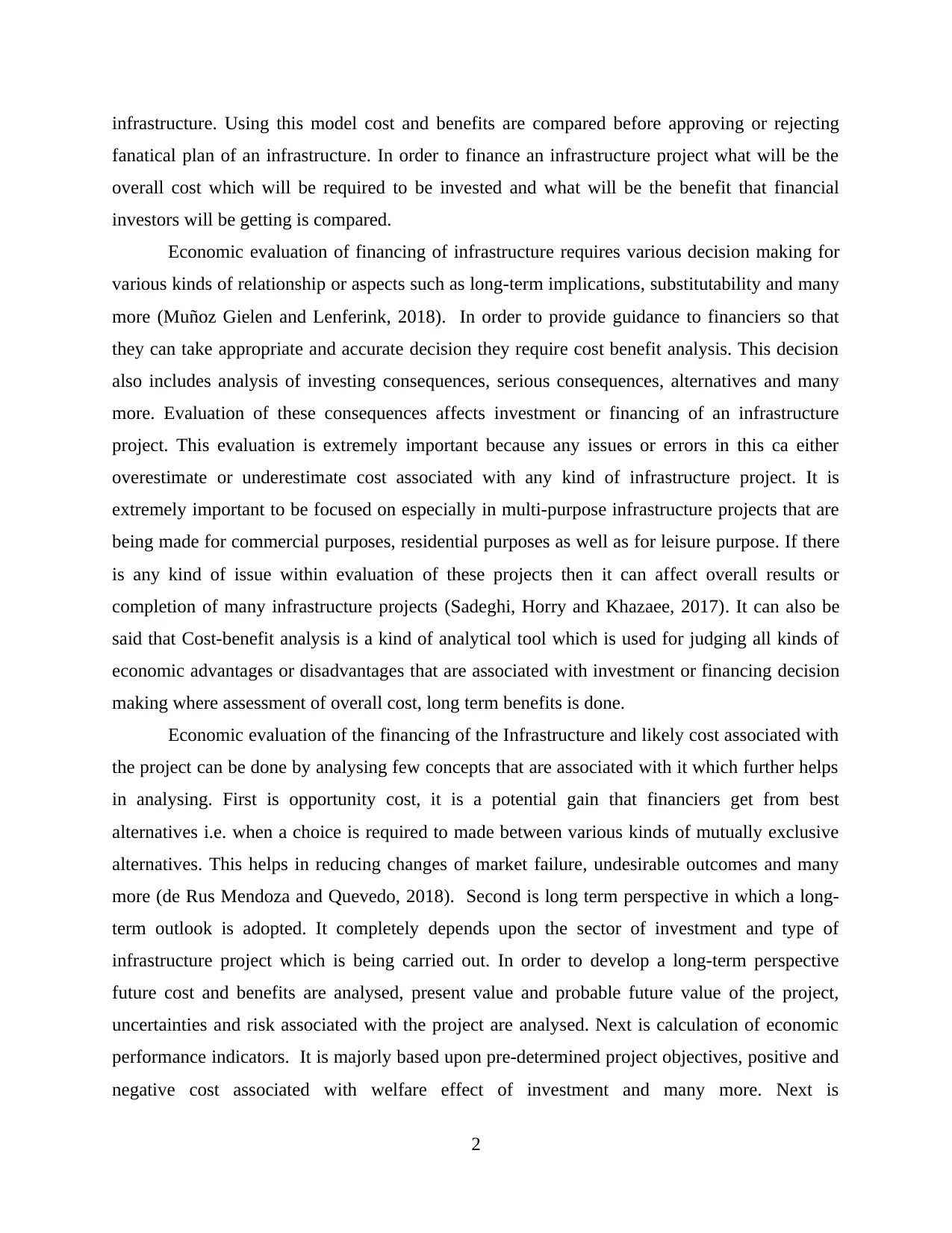
infrastructure. Using this model cost and benefits are compared before approving or rejecting
fanatical plan of an infrastructure. In order to finance an infrastructure project what will be the
overall cost which will be required to be invested and what will be the benefit that financial
investors will be getting is compared.
Economic evaluation of financing of infrastructure requires various decision making for
various kinds of relationship or aspects such as long-term implications, substitutability and many
more (Muñoz Gielen and Lenferink, 2018). In order to provide guidance to financiers so that
they can take appropriate and accurate decision they require cost benefit analysis. This decision
also includes analysis of investing consequences, serious consequences, alternatives and many
more. Evaluation of these consequences affects investment or financing of an infrastructure
project. This evaluation is extremely important because any issues or errors in this ca either
overestimate or underestimate cost associated with any kind of infrastructure project. It is
extremely important to be focused on especially in multi-purpose infrastructure projects that are
being made for commercial purposes, residential purposes as well as for leisure purpose. If there
is any kind of issue within evaluation of these projects then it can affect overall results or
completion of many infrastructure projects (Sadeghi, Horry and Khazaee, 2017). It can also be
said that Cost-benefit analysis is a kind of analytical tool which is used for judging all kinds of
economic advantages or disadvantages that are associated with investment or financing decision
making where assessment of overall cost, long term benefits is done.
Economic evaluation of the financing of the Infrastructure and likely cost associated with
the project can be done by analysing few concepts that are associated with it which further helps
in analysing. First is opportunity cost, it is a potential gain that financiers get from best
alternatives i.e. when a choice is required to made between various kinds of mutually exclusive
alternatives. This helps in reducing changes of market failure, undesirable outcomes and many
more (de Rus Mendoza and Quevedo, 2018). Second is long term perspective in which a long-
term outlook is adopted. It completely depends upon the sector of investment and type of
infrastructure project which is being carried out. In order to develop a long-term perspective
future cost and benefits are analysed, present value and probable future value of the project,
uncertainties and risk associated with the project are analysed. Next is calculation of economic
performance indicators. It is majorly based upon pre-determined project objectives, positive and
negative cost associated with welfare effect of investment and many more. Next is
2
fanatical plan of an infrastructure. In order to finance an infrastructure project what will be the
overall cost which will be required to be invested and what will be the benefit that financial
investors will be getting is compared.
Economic evaluation of financing of infrastructure requires various decision making for
various kinds of relationship or aspects such as long-term implications, substitutability and many
more (Muñoz Gielen and Lenferink, 2018). In order to provide guidance to financiers so that
they can take appropriate and accurate decision they require cost benefit analysis. This decision
also includes analysis of investing consequences, serious consequences, alternatives and many
more. Evaluation of these consequences affects investment or financing of an infrastructure
project. This evaluation is extremely important because any issues or errors in this ca either
overestimate or underestimate cost associated with any kind of infrastructure project. It is
extremely important to be focused on especially in multi-purpose infrastructure projects that are
being made for commercial purposes, residential purposes as well as for leisure purpose. If there
is any kind of issue within evaluation of these projects then it can affect overall results or
completion of many infrastructure projects (Sadeghi, Horry and Khazaee, 2017). It can also be
said that Cost-benefit analysis is a kind of analytical tool which is used for judging all kinds of
economic advantages or disadvantages that are associated with investment or financing decision
making where assessment of overall cost, long term benefits is done.
Economic evaluation of the financing of the Infrastructure and likely cost associated with
the project can be done by analysing few concepts that are associated with it which further helps
in analysing. First is opportunity cost, it is a potential gain that financiers get from best
alternatives i.e. when a choice is required to made between various kinds of mutually exclusive
alternatives. This helps in reducing changes of market failure, undesirable outcomes and many
more (de Rus Mendoza and Quevedo, 2018). Second is long term perspective in which a long-
term outlook is adopted. It completely depends upon the sector of investment and type of
infrastructure project which is being carried out. In order to develop a long-term perspective
future cost and benefits are analysed, present value and probable future value of the project,
uncertainties and risk associated with the project are analysed. Next is calculation of economic
performance indicators. It is majorly based upon pre-determined project objectives, positive and
negative cost associated with welfare effect of investment and many more. Next is
2
Secure Best Marks with AI Grader
Need help grading? Try our AI Grader for instant feedback on your assignments.
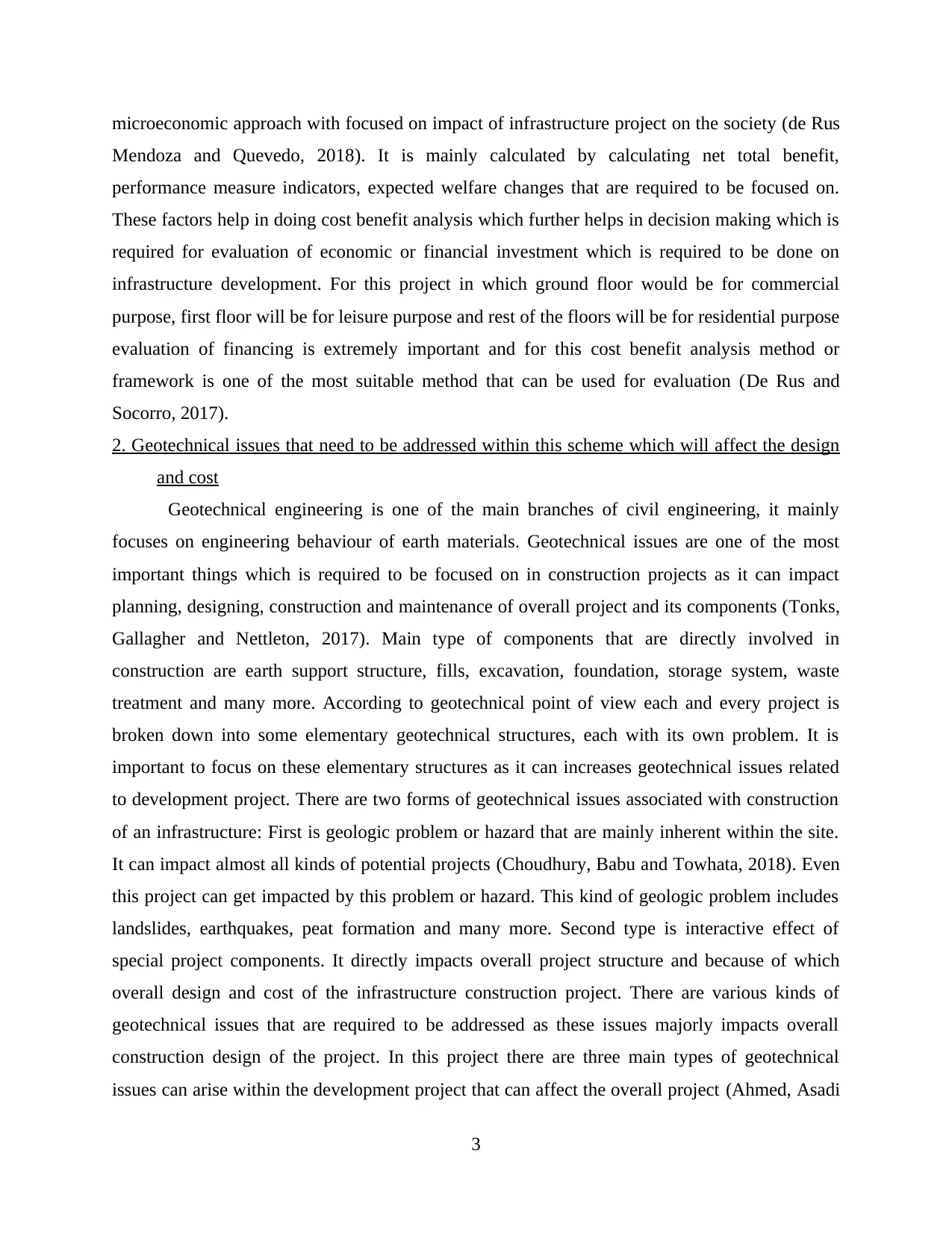
microeconomic approach with focused on impact of infrastructure project on the society (de Rus
Mendoza and Quevedo, 2018). It is mainly calculated by calculating net total benefit,
performance measure indicators, expected welfare changes that are required to be focused on.
These factors help in doing cost benefit analysis which further helps in decision making which is
required for evaluation of economic or financial investment which is required to be done on
infrastructure development. For this project in which ground floor would be for commercial
purpose, first floor will be for leisure purpose and rest of the floors will be for residential purpose
evaluation of financing is extremely important and for this cost benefit analysis method or
framework is one of the most suitable method that can be used for evaluation (De Rus and
Socorro, 2017).
2. Geotechnical issues that need to be addressed within this scheme which will affect the design
and cost
Geotechnical engineering is one of the main branches of civil engineering, it mainly
focuses on engineering behaviour of earth materials. Geotechnical issues are one of the most
important things which is required to be focused on in construction projects as it can impact
planning, designing, construction and maintenance of overall project and its components (Tonks,
Gallagher and Nettleton, 2017). Main type of components that are directly involved in
construction are earth support structure, fills, excavation, foundation, storage system, waste
treatment and many more. According to geotechnical point of view each and every project is
broken down into some elementary geotechnical structures, each with its own problem. It is
important to focus on these elementary structures as it can increases geotechnical issues related
to development project. There are two forms of geotechnical issues associated with construction
of an infrastructure: First is geologic problem or hazard that are mainly inherent within the site.
It can impact almost all kinds of potential projects (Choudhury, Babu and Towhata, 2018). Even
this project can get impacted by this problem or hazard. This kind of geologic problem includes
landslides, earthquakes, peat formation and many more. Second type is interactive effect of
special project components. It directly impacts overall project structure and because of which
overall design and cost of the infrastructure construction project. There are various kinds of
geotechnical issues that are required to be addressed as these issues majorly impacts overall
construction design of the project. In this project there are three main types of geotechnical
issues can arise within the development project that can affect the overall project (Ahmed, Asadi
3
Mendoza and Quevedo, 2018). It is mainly calculated by calculating net total benefit,
performance measure indicators, expected welfare changes that are required to be focused on.
These factors help in doing cost benefit analysis which further helps in decision making which is
required for evaluation of economic or financial investment which is required to be done on
infrastructure development. For this project in which ground floor would be for commercial
purpose, first floor will be for leisure purpose and rest of the floors will be for residential purpose
evaluation of financing is extremely important and for this cost benefit analysis method or
framework is one of the most suitable method that can be used for evaluation (De Rus and
Socorro, 2017).
2. Geotechnical issues that need to be addressed within this scheme which will affect the design
and cost
Geotechnical engineering is one of the main branches of civil engineering, it mainly
focuses on engineering behaviour of earth materials. Geotechnical issues are one of the most
important things which is required to be focused on in construction projects as it can impact
planning, designing, construction and maintenance of overall project and its components (Tonks,
Gallagher and Nettleton, 2017). Main type of components that are directly involved in
construction are earth support structure, fills, excavation, foundation, storage system, waste
treatment and many more. According to geotechnical point of view each and every project is
broken down into some elementary geotechnical structures, each with its own problem. It is
important to focus on these elementary structures as it can increases geotechnical issues related
to development project. There are two forms of geotechnical issues associated with construction
of an infrastructure: First is geologic problem or hazard that are mainly inherent within the site.
It can impact almost all kinds of potential projects (Choudhury, Babu and Towhata, 2018). Even
this project can get impacted by this problem or hazard. This kind of geologic problem includes
landslides, earthquakes, peat formation and many more. Second type is interactive effect of
special project components. It directly impacts overall project structure and because of which
overall design and cost of the infrastructure construction project. There are various kinds of
geotechnical issues that are required to be addressed as these issues majorly impacts overall
construction design of the project. In this project there are three main types of geotechnical
issues can arise within the development project that can affect the overall project (Ahmed, Asadi
3
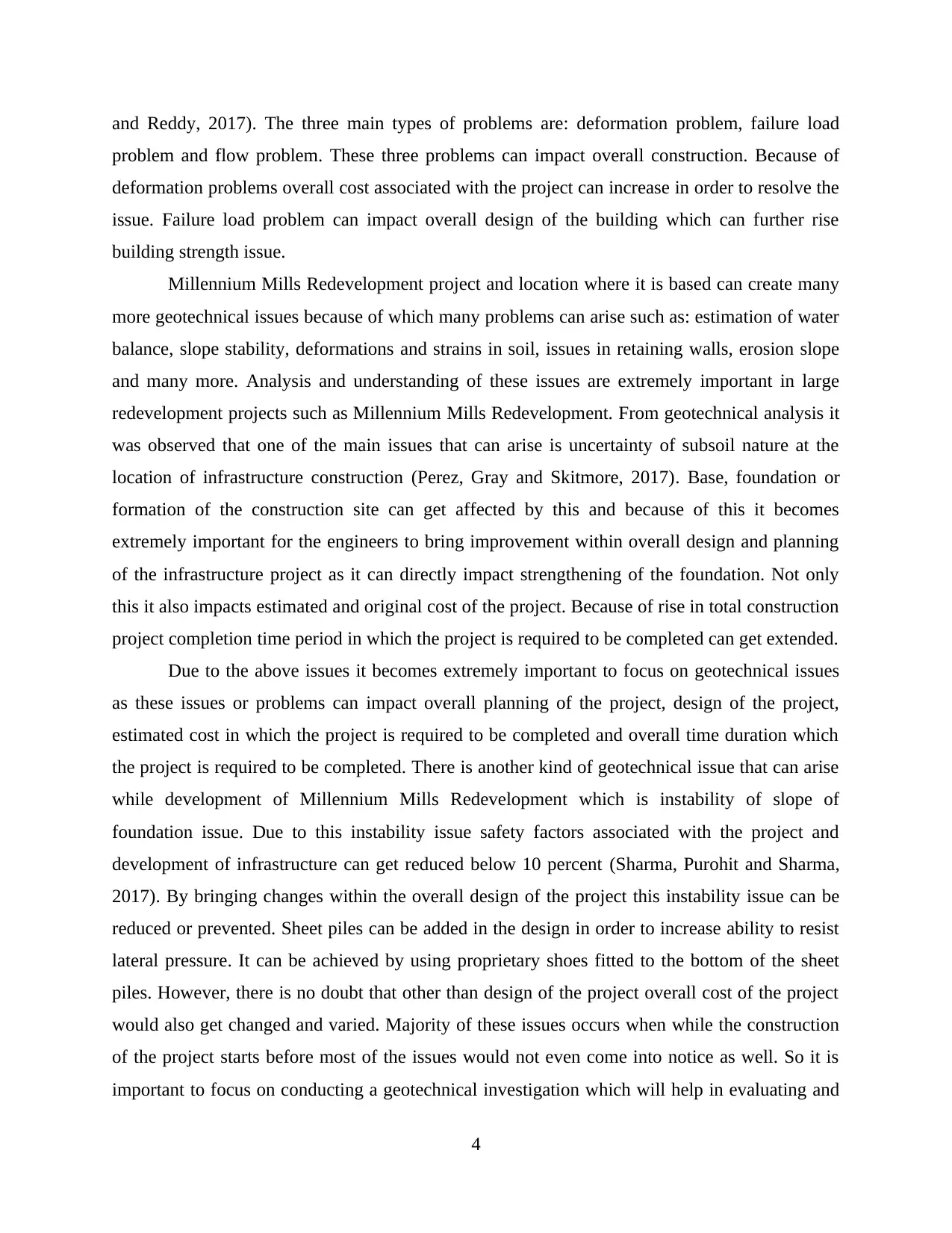
and Reddy, 2017). The three main types of problems are: deformation problem, failure load
problem and flow problem. These three problems can impact overall construction. Because of
deformation problems overall cost associated with the project can increase in order to resolve the
issue. Failure load problem can impact overall design of the building which can further rise
building strength issue.
Millennium Mills Redevelopment project and location where it is based can create many
more geotechnical issues because of which many problems can arise such as: estimation of water
balance, slope stability, deformations and strains in soil, issues in retaining walls, erosion slope
and many more. Analysis and understanding of these issues are extremely important in large
redevelopment projects such as Millennium Mills Redevelopment. From geotechnical analysis it
was observed that one of the main issues that can arise is uncertainty of subsoil nature at the
location of infrastructure construction (Perez, Gray and Skitmore, 2017). Base, foundation or
formation of the construction site can get affected by this and because of this it becomes
extremely important for the engineers to bring improvement within overall design and planning
of the infrastructure project as it can directly impact strengthening of the foundation. Not only
this it also impacts estimated and original cost of the project. Because of rise in total construction
project completion time period in which the project is required to be completed can get extended.
Due to the above issues it becomes extremely important to focus on geotechnical issues
as these issues or problems can impact overall planning of the project, design of the project,
estimated cost in which the project is required to be completed and overall time duration which
the project is required to be completed. There is another kind of geotechnical issue that can arise
while development of Millennium Mills Redevelopment which is instability of slope of
foundation issue. Due to this instability issue safety factors associated with the project and
development of infrastructure can get reduced below 10 percent (Sharma, Purohit and Sharma,
2017). By bringing changes within the overall design of the project this instability issue can be
reduced or prevented. Sheet piles can be added in the design in order to increase ability to resist
lateral pressure. It can be achieved by using proprietary shoes fitted to the bottom of the sheet
piles. However, there is no doubt that other than design of the project overall cost of the project
would also get changed and varied. Majority of these issues occurs when while the construction
of the project starts before most of the issues would not even come into notice as well. So it is
important to focus on conducting a geotechnical investigation which will help in evaluating and
4
problem and flow problem. These three problems can impact overall construction. Because of
deformation problems overall cost associated with the project can increase in order to resolve the
issue. Failure load problem can impact overall design of the building which can further rise
building strength issue.
Millennium Mills Redevelopment project and location where it is based can create many
more geotechnical issues because of which many problems can arise such as: estimation of water
balance, slope stability, deformations and strains in soil, issues in retaining walls, erosion slope
and many more. Analysis and understanding of these issues are extremely important in large
redevelopment projects such as Millennium Mills Redevelopment. From geotechnical analysis it
was observed that one of the main issues that can arise is uncertainty of subsoil nature at the
location of infrastructure construction (Perez, Gray and Skitmore, 2017). Base, foundation or
formation of the construction site can get affected by this and because of this it becomes
extremely important for the engineers to bring improvement within overall design and planning
of the infrastructure project as it can directly impact strengthening of the foundation. Not only
this it also impacts estimated and original cost of the project. Because of rise in total construction
project completion time period in which the project is required to be completed can get extended.
Due to the above issues it becomes extremely important to focus on geotechnical issues
as these issues or problems can impact overall planning of the project, design of the project,
estimated cost in which the project is required to be completed and overall time duration which
the project is required to be completed. There is another kind of geotechnical issue that can arise
while development of Millennium Mills Redevelopment which is instability of slope of
foundation issue. Due to this instability issue safety factors associated with the project and
development of infrastructure can get reduced below 10 percent (Sharma, Purohit and Sharma,
2017). By bringing changes within the overall design of the project this instability issue can be
reduced or prevented. Sheet piles can be added in the design in order to increase ability to resist
lateral pressure. It can be achieved by using proprietary shoes fitted to the bottom of the sheet
piles. However, there is no doubt that other than design of the project overall cost of the project
would also get changed and varied. Majority of these issues occurs when while the construction
of the project starts before most of the issues would not even come into notice as well. So it is
important to focus on conducting a geotechnical investigation which will help in evaluating and
4
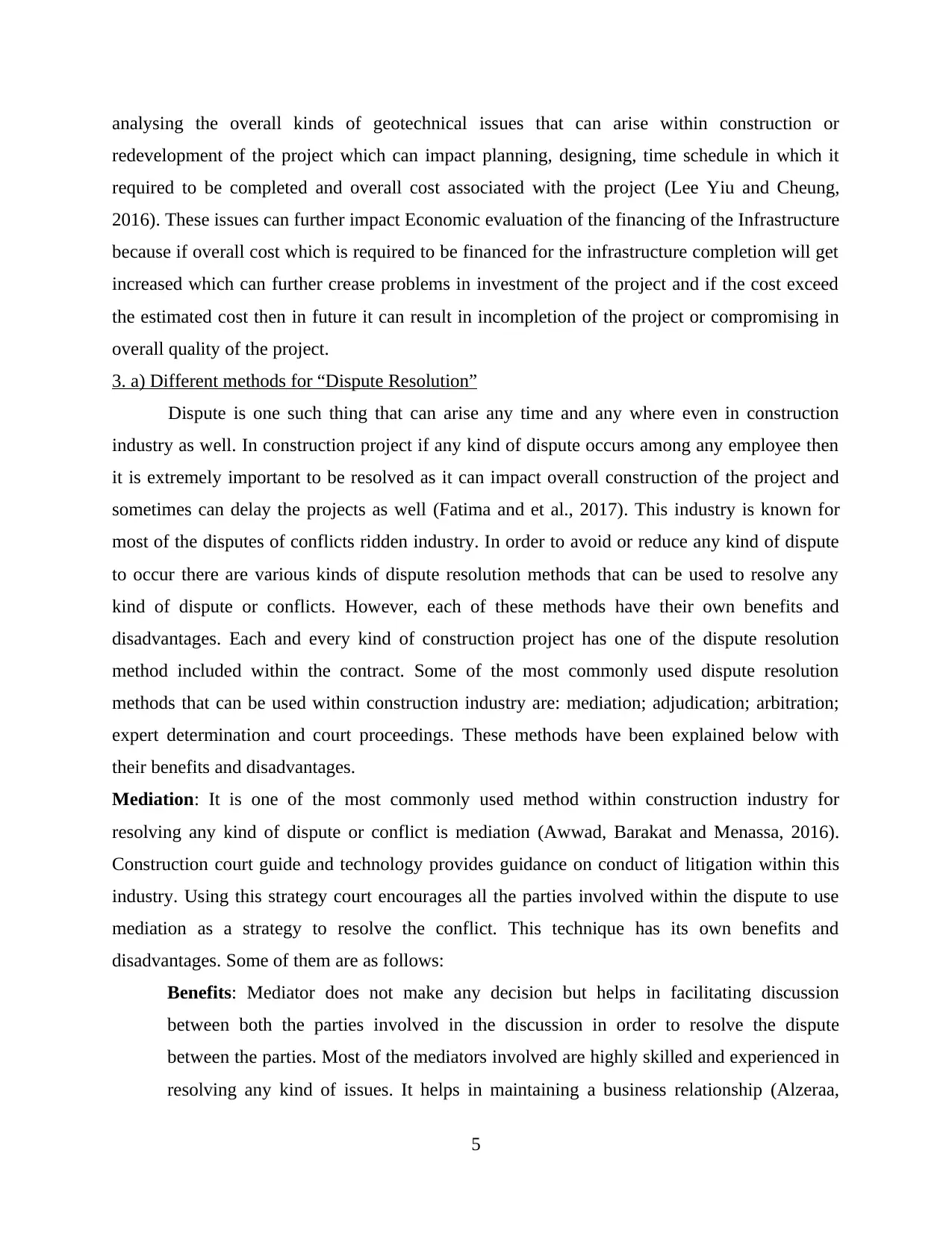
analysing the overall kinds of geotechnical issues that can arise within construction or
redevelopment of the project which can impact planning, designing, time schedule in which it
required to be completed and overall cost associated with the project (Lee Yiu and Cheung,
2016). These issues can further impact Economic evaluation of the financing of the Infrastructure
because if overall cost which is required to be financed for the infrastructure completion will get
increased which can further crease problems in investment of the project and if the cost exceed
the estimated cost then in future it can result in incompletion of the project or compromising in
overall quality of the project.
3. a) Different methods for “Dispute Resolution”
Dispute is one such thing that can arise any time and any where even in construction
industry as well. In construction project if any kind of dispute occurs among any employee then
it is extremely important to be resolved as it can impact overall construction of the project and
sometimes can delay the projects as well (Fatima and et al., 2017). This industry is known for
most of the disputes of conflicts ridden industry. In order to avoid or reduce any kind of dispute
to occur there are various kinds of dispute resolution methods that can be used to resolve any
kind of dispute or conflicts. However, each of these methods have their own benefits and
disadvantages. Each and every kind of construction project has one of the dispute resolution
method included within the contract. Some of the most commonly used dispute resolution
methods that can be used within construction industry are: mediation; adjudication; arbitration;
expert determination and court proceedings. These methods have been explained below with
their benefits and disadvantages.
Mediation: It is one of the most commonly used method within construction industry for
resolving any kind of dispute or conflict is mediation (Awwad, Barakat and Menassa, 2016).
Construction court guide and technology provides guidance on conduct of litigation within this
industry. Using this strategy court encourages all the parties involved within the dispute to use
mediation as a strategy to resolve the conflict. This technique has its own benefits and
disadvantages. Some of them are as follows:
Benefits: Mediator does not make any decision but helps in facilitating discussion
between both the parties involved in the discussion in order to resolve the dispute
between the parties. Most of the mediators involved are highly skilled and experienced in
resolving any kind of issues. It helps in maintaining a business relationship (Alzeraa,
5
redevelopment of the project which can impact planning, designing, time schedule in which it
required to be completed and overall cost associated with the project (Lee Yiu and Cheung,
2016). These issues can further impact Economic evaluation of the financing of the Infrastructure
because if overall cost which is required to be financed for the infrastructure completion will get
increased which can further crease problems in investment of the project and if the cost exceed
the estimated cost then in future it can result in incompletion of the project or compromising in
overall quality of the project.
3. a) Different methods for “Dispute Resolution”
Dispute is one such thing that can arise any time and any where even in construction
industry as well. In construction project if any kind of dispute occurs among any employee then
it is extremely important to be resolved as it can impact overall construction of the project and
sometimes can delay the projects as well (Fatima and et al., 2017). This industry is known for
most of the disputes of conflicts ridden industry. In order to avoid or reduce any kind of dispute
to occur there are various kinds of dispute resolution methods that can be used to resolve any
kind of dispute or conflicts. However, each of these methods have their own benefits and
disadvantages. Each and every kind of construction project has one of the dispute resolution
method included within the contract. Some of the most commonly used dispute resolution
methods that can be used within construction industry are: mediation; adjudication; arbitration;
expert determination and court proceedings. These methods have been explained below with
their benefits and disadvantages.
Mediation: It is one of the most commonly used method within construction industry for
resolving any kind of dispute or conflict is mediation (Awwad, Barakat and Menassa, 2016).
Construction court guide and technology provides guidance on conduct of litigation within this
industry. Using this strategy court encourages all the parties involved within the dispute to use
mediation as a strategy to resolve the conflict. This technique has its own benefits and
disadvantages. Some of them are as follows:
Benefits: Mediator does not make any decision but helps in facilitating discussion
between both the parties involved in the discussion in order to resolve the dispute
between the parties. Most of the mediators involved are highly skilled and experienced in
resolving any kind of issues. It helps in maintaining a business relationship (Alzeraa,
5
Paraphrase This Document
Need a fresh take? Get an instant paraphrase of this document with our AI Paraphraser
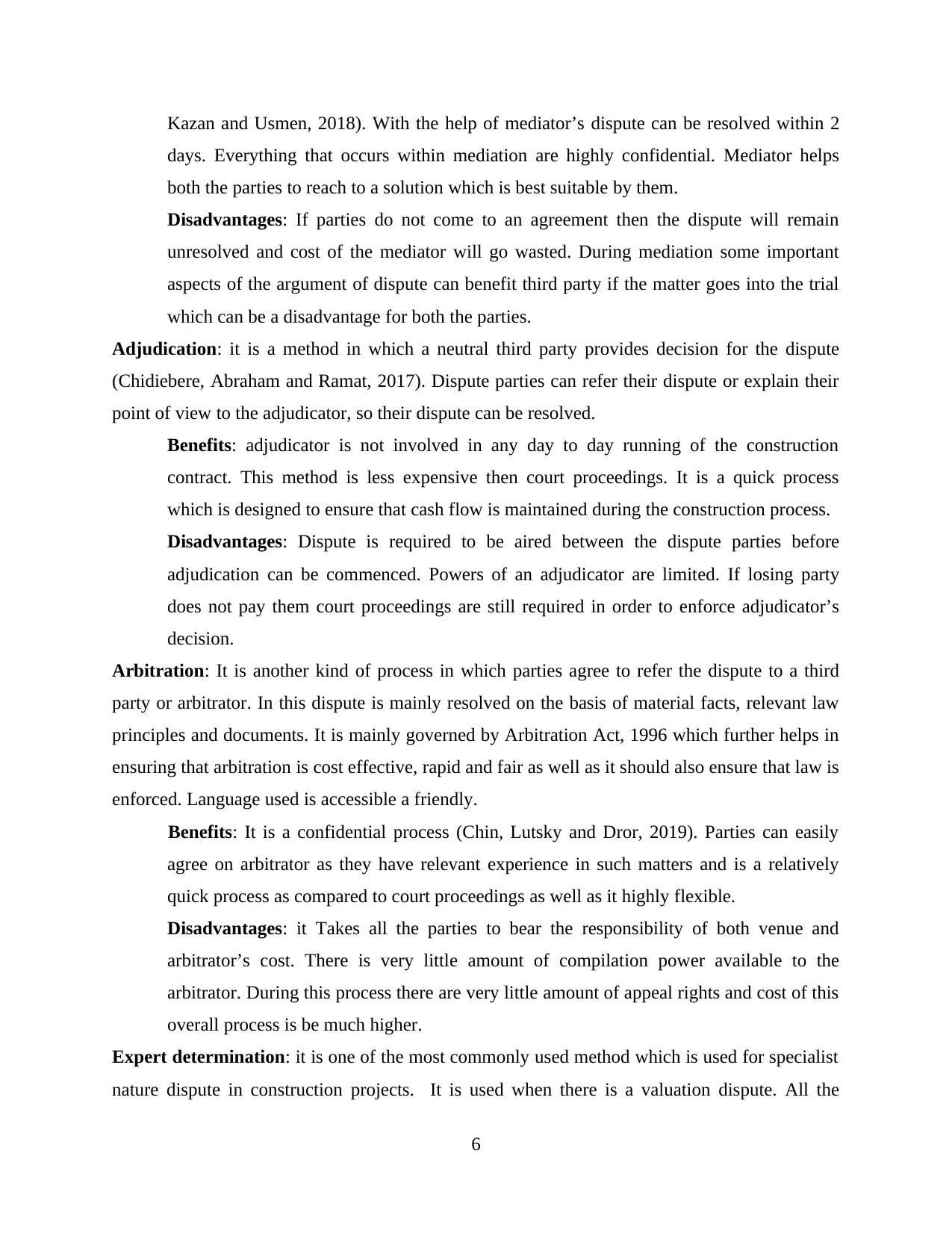
Kazan and Usmen, 2018). With the help of mediator’s dispute can be resolved within 2
days. Everything that occurs within mediation are highly confidential. Mediator helps
both the parties to reach to a solution which is best suitable by them.
Disadvantages: If parties do not come to an agreement then the dispute will remain
unresolved and cost of the mediator will go wasted. During mediation some important
aspects of the argument of dispute can benefit third party if the matter goes into the trial
which can be a disadvantage for both the parties.
Adjudication: it is a method in which a neutral third party provides decision for the dispute
(Chidiebere, Abraham and Ramat, 2017). Dispute parties can refer their dispute or explain their
point of view to the adjudicator, so their dispute can be resolved.
Benefits: adjudicator is not involved in any day to day running of the construction
contract. This method is less expensive then court proceedings. It is a quick process
which is designed to ensure that cash flow is maintained during the construction process.
Disadvantages: Dispute is required to be aired between the dispute parties before
adjudication can be commenced. Powers of an adjudicator are limited. If losing party
does not pay them court proceedings are still required in order to enforce adjudicator’s
decision.
Arbitration: It is another kind of process in which parties agree to refer the dispute to a third
party or arbitrator. In this dispute is mainly resolved on the basis of material facts, relevant law
principles and documents. It is mainly governed by Arbitration Act, 1996 which further helps in
ensuring that arbitration is cost effective, rapid and fair as well as it should also ensure that law is
enforced. Language used is accessible a friendly.
Benefits: It is a confidential process (Chin, Lutsky and Dror, 2019). Parties can easily
agree on arbitrator as they have relevant experience in such matters and is a relatively
quick process as compared to court proceedings as well as it highly flexible.
Disadvantages: it Takes all the parties to bear the responsibility of both venue and
arbitrator’s cost. There is very little amount of compilation power available to the
arbitrator. During this process there are very little amount of appeal rights and cost of this
overall process is be much higher.
Expert determination: it is one of the most commonly used method which is used for specialist
nature dispute in construction projects. It is used when there is a valuation dispute. All the
6
days. Everything that occurs within mediation are highly confidential. Mediator helps
both the parties to reach to a solution which is best suitable by them.
Disadvantages: If parties do not come to an agreement then the dispute will remain
unresolved and cost of the mediator will go wasted. During mediation some important
aspects of the argument of dispute can benefit third party if the matter goes into the trial
which can be a disadvantage for both the parties.
Adjudication: it is a method in which a neutral third party provides decision for the dispute
(Chidiebere, Abraham and Ramat, 2017). Dispute parties can refer their dispute or explain their
point of view to the adjudicator, so their dispute can be resolved.
Benefits: adjudicator is not involved in any day to day running of the construction
contract. This method is less expensive then court proceedings. It is a quick process
which is designed to ensure that cash flow is maintained during the construction process.
Disadvantages: Dispute is required to be aired between the dispute parties before
adjudication can be commenced. Powers of an adjudicator are limited. If losing party
does not pay them court proceedings are still required in order to enforce adjudicator’s
decision.
Arbitration: It is another kind of process in which parties agree to refer the dispute to a third
party or arbitrator. In this dispute is mainly resolved on the basis of material facts, relevant law
principles and documents. It is mainly governed by Arbitration Act, 1996 which further helps in
ensuring that arbitration is cost effective, rapid and fair as well as it should also ensure that law is
enforced. Language used is accessible a friendly.
Benefits: It is a confidential process (Chin, Lutsky and Dror, 2019). Parties can easily
agree on arbitrator as they have relevant experience in such matters and is a relatively
quick process as compared to court proceedings as well as it highly flexible.
Disadvantages: it Takes all the parties to bear the responsibility of both venue and
arbitrator’s cost. There is very little amount of compilation power available to the
arbitrator. During this process there are very little amount of appeal rights and cost of this
overall process is be much higher.
Expert determination: it is one of the most commonly used method which is used for specialist
nature dispute in construction projects. It is used when there is a valuation dispute. All the
6
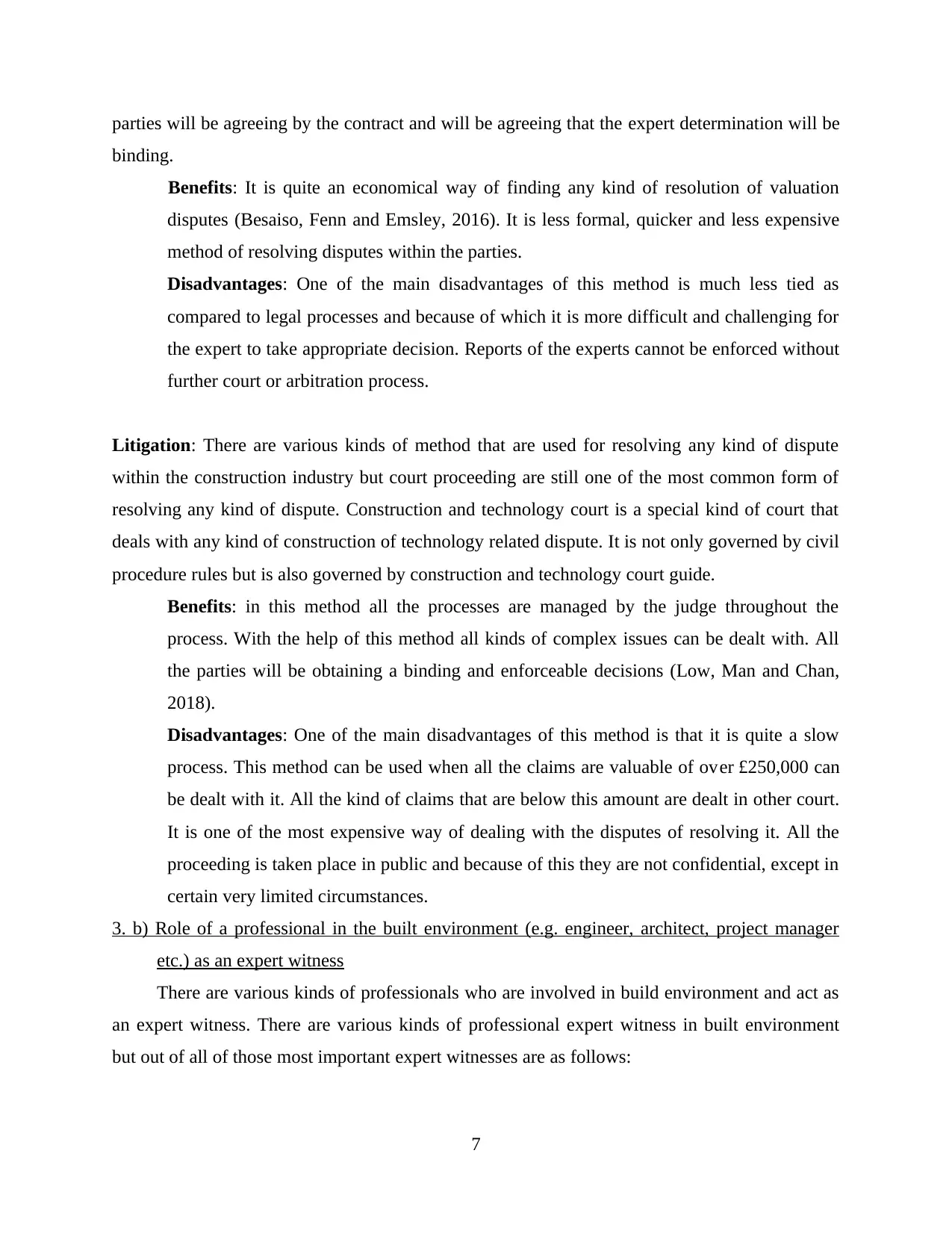
parties will be agreeing by the contract and will be agreeing that the expert determination will be
binding.
Benefits: It is quite an economical way of finding any kind of resolution of valuation
disputes (Besaiso, Fenn and Emsley, 2016). It is less formal, quicker and less expensive
method of resolving disputes within the parties.
Disadvantages: One of the main disadvantages of this method is much less tied as
compared to legal processes and because of which it is more difficult and challenging for
the expert to take appropriate decision. Reports of the experts cannot be enforced without
further court or arbitration process.
Litigation: There are various kinds of method that are used for resolving any kind of dispute
within the construction industry but court proceeding are still one of the most common form of
resolving any kind of dispute. Construction and technology court is a special kind of court that
deals with any kind of construction of technology related dispute. It is not only governed by civil
procedure rules but is also governed by construction and technology court guide.
Benefits: in this method all the processes are managed by the judge throughout the
process. With the help of this method all kinds of complex issues can be dealt with. All
the parties will be obtaining a binding and enforceable decisions (Low, Man and Chan,
2018).
Disadvantages: One of the main disadvantages of this method is that it is quite a slow
process. This method can be used when all the claims are valuable of over £250,000 can
be dealt with it. All the kind of claims that are below this amount are dealt in other court.
It is one of the most expensive way of dealing with the disputes of resolving it. All the
proceeding is taken place in public and because of this they are not confidential, except in
certain very limited circumstances.
3. b) Role of a professional in the built environment (e.g. engineer, architect, project manager
etc.) as an expert witness
There are various kinds of professionals who are involved in build environment and act as
an expert witness. There are various kinds of professional expert witness in built environment
but out of all of those most important expert witnesses are as follows:
7
binding.
Benefits: It is quite an economical way of finding any kind of resolution of valuation
disputes (Besaiso, Fenn and Emsley, 2016). It is less formal, quicker and less expensive
method of resolving disputes within the parties.
Disadvantages: One of the main disadvantages of this method is much less tied as
compared to legal processes and because of which it is more difficult and challenging for
the expert to take appropriate decision. Reports of the experts cannot be enforced without
further court or arbitration process.
Litigation: There are various kinds of method that are used for resolving any kind of dispute
within the construction industry but court proceeding are still one of the most common form of
resolving any kind of dispute. Construction and technology court is a special kind of court that
deals with any kind of construction of technology related dispute. It is not only governed by civil
procedure rules but is also governed by construction and technology court guide.
Benefits: in this method all the processes are managed by the judge throughout the
process. With the help of this method all kinds of complex issues can be dealt with. All
the parties will be obtaining a binding and enforceable decisions (Low, Man and Chan,
2018).
Disadvantages: One of the main disadvantages of this method is that it is quite a slow
process. This method can be used when all the claims are valuable of over £250,000 can
be dealt with it. All the kind of claims that are below this amount are dealt in other court.
It is one of the most expensive way of dealing with the disputes of resolving it. All the
proceeding is taken place in public and because of this they are not confidential, except in
certain very limited circumstances.
3. b) Role of a professional in the built environment (e.g. engineer, architect, project manager
etc.) as an expert witness
There are various kinds of professionals who are involved in build environment and act as
an expert witness. There are various kinds of professional expert witness in built environment
but out of all of those most important expert witnesses are as follows:
7
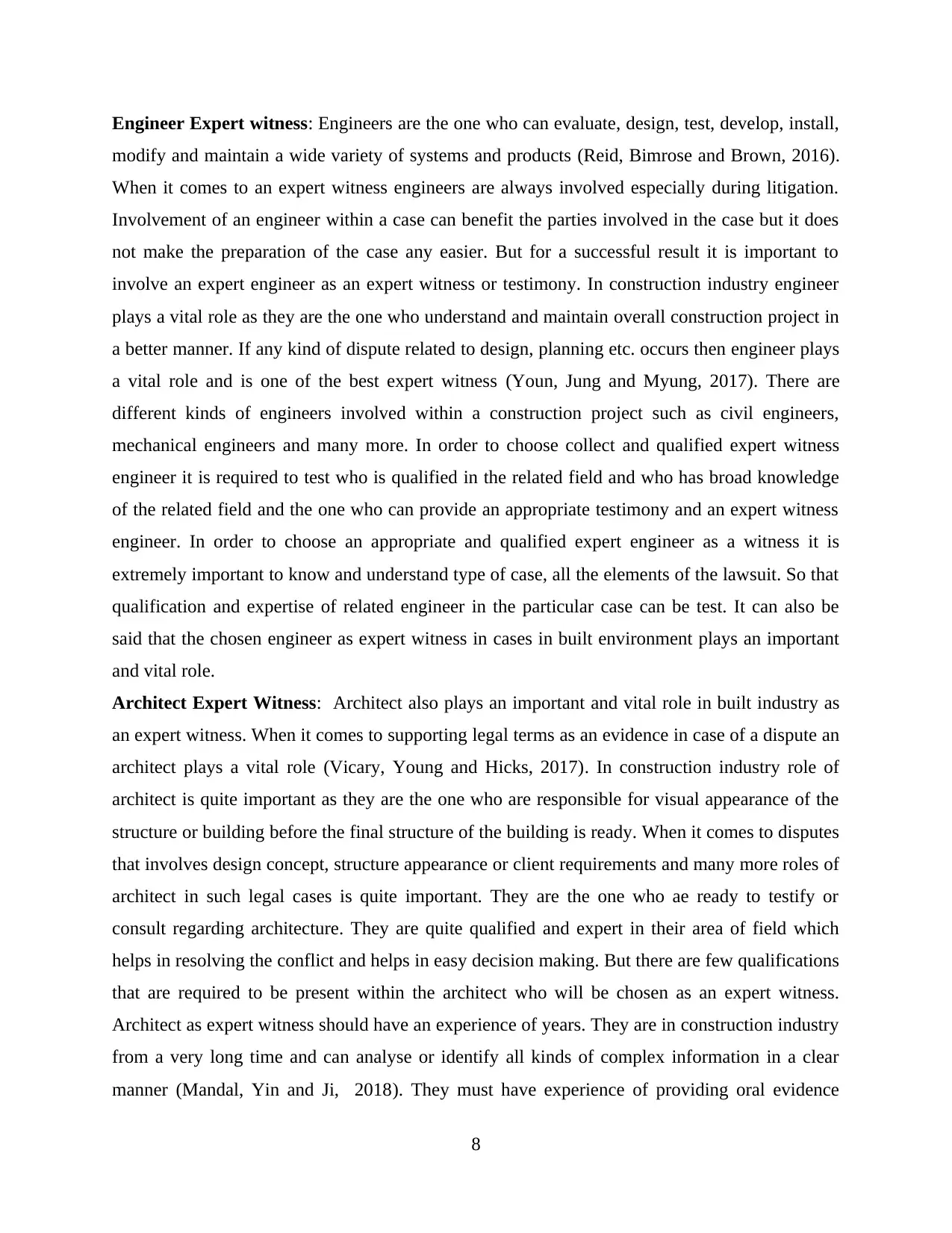
Engineer Expert witness: Engineers are the one who can evaluate, design, test, develop, install,
modify and maintain a wide variety of systems and products (Reid, Bimrose and Brown, 2016).
When it comes to an expert witness engineers are always involved especially during litigation.
Involvement of an engineer within a case can benefit the parties involved in the case but it does
not make the preparation of the case any easier. But for a successful result it is important to
involve an expert engineer as an expert witness or testimony. In construction industry engineer
plays a vital role as they are the one who understand and maintain overall construction project in
a better manner. If any kind of dispute related to design, planning etc. occurs then engineer plays
a vital role and is one of the best expert witness (Youn, Jung and Myung, 2017). There are
different kinds of engineers involved within a construction project such as civil engineers,
mechanical engineers and many more. In order to choose collect and qualified expert witness
engineer it is required to test who is qualified in the related field and who has broad knowledge
of the related field and the one who can provide an appropriate testimony and an expert witness
engineer. In order to choose an appropriate and qualified expert engineer as a witness it is
extremely important to know and understand type of case, all the elements of the lawsuit. So that
qualification and expertise of related engineer in the particular case can be test. It can also be
said that the chosen engineer as expert witness in cases in built environment plays an important
and vital role.
Architect Expert Witness: Architect also plays an important and vital role in built industry as
an expert witness. When it comes to supporting legal terms as an evidence in case of a dispute an
architect plays a vital role (Vicary, Young and Hicks, 2017). In construction industry role of
architect is quite important as they are the one who are responsible for visual appearance of the
structure or building before the final structure of the building is ready. When it comes to disputes
that involves design concept, structure appearance or client requirements and many more roles of
architect in such legal cases is quite important. They are the one who ae ready to testify or
consult regarding architecture. They are quite qualified and expert in their area of field which
helps in resolving the conflict and helps in easy decision making. But there are few qualifications
that are required to be present within the architect who will be chosen as an expert witness.
Architect as expert witness should have an experience of years. They are in construction industry
from a very long time and can analyse or identify all kinds of complex information in a clear
manner (Mandal, Yin and Ji, 2018). They must have experience of providing oral evidence
8
modify and maintain a wide variety of systems and products (Reid, Bimrose and Brown, 2016).
When it comes to an expert witness engineers are always involved especially during litigation.
Involvement of an engineer within a case can benefit the parties involved in the case but it does
not make the preparation of the case any easier. But for a successful result it is important to
involve an expert engineer as an expert witness or testimony. In construction industry engineer
plays a vital role as they are the one who understand and maintain overall construction project in
a better manner. If any kind of dispute related to design, planning etc. occurs then engineer plays
a vital role and is one of the best expert witness (Youn, Jung and Myung, 2017). There are
different kinds of engineers involved within a construction project such as civil engineers,
mechanical engineers and many more. In order to choose collect and qualified expert witness
engineer it is required to test who is qualified in the related field and who has broad knowledge
of the related field and the one who can provide an appropriate testimony and an expert witness
engineer. In order to choose an appropriate and qualified expert engineer as a witness it is
extremely important to know and understand type of case, all the elements of the lawsuit. So that
qualification and expertise of related engineer in the particular case can be test. It can also be
said that the chosen engineer as expert witness in cases in built environment plays an important
and vital role.
Architect Expert Witness: Architect also plays an important and vital role in built industry as
an expert witness. When it comes to supporting legal terms as an evidence in case of a dispute an
architect plays a vital role (Vicary, Young and Hicks, 2017). In construction industry role of
architect is quite important as they are the one who are responsible for visual appearance of the
structure or building before the final structure of the building is ready. When it comes to disputes
that involves design concept, structure appearance or client requirements and many more roles of
architect in such legal cases is quite important. They are the one who ae ready to testify or
consult regarding architecture. They are quite qualified and expert in their area of field which
helps in resolving the conflict and helps in easy decision making. But there are few qualifications
that are required to be present within the architect who will be chosen as an expert witness.
Architect as expert witness should have an experience of years. They are in construction industry
from a very long time and can analyse or identify all kinds of complex information in a clear
manner (Mandal, Yin and Ji, 2018). They must have experience of providing oral evidence
8
Secure Best Marks with AI Grader
Need help grading? Try our AI Grader for instant feedback on your assignments.
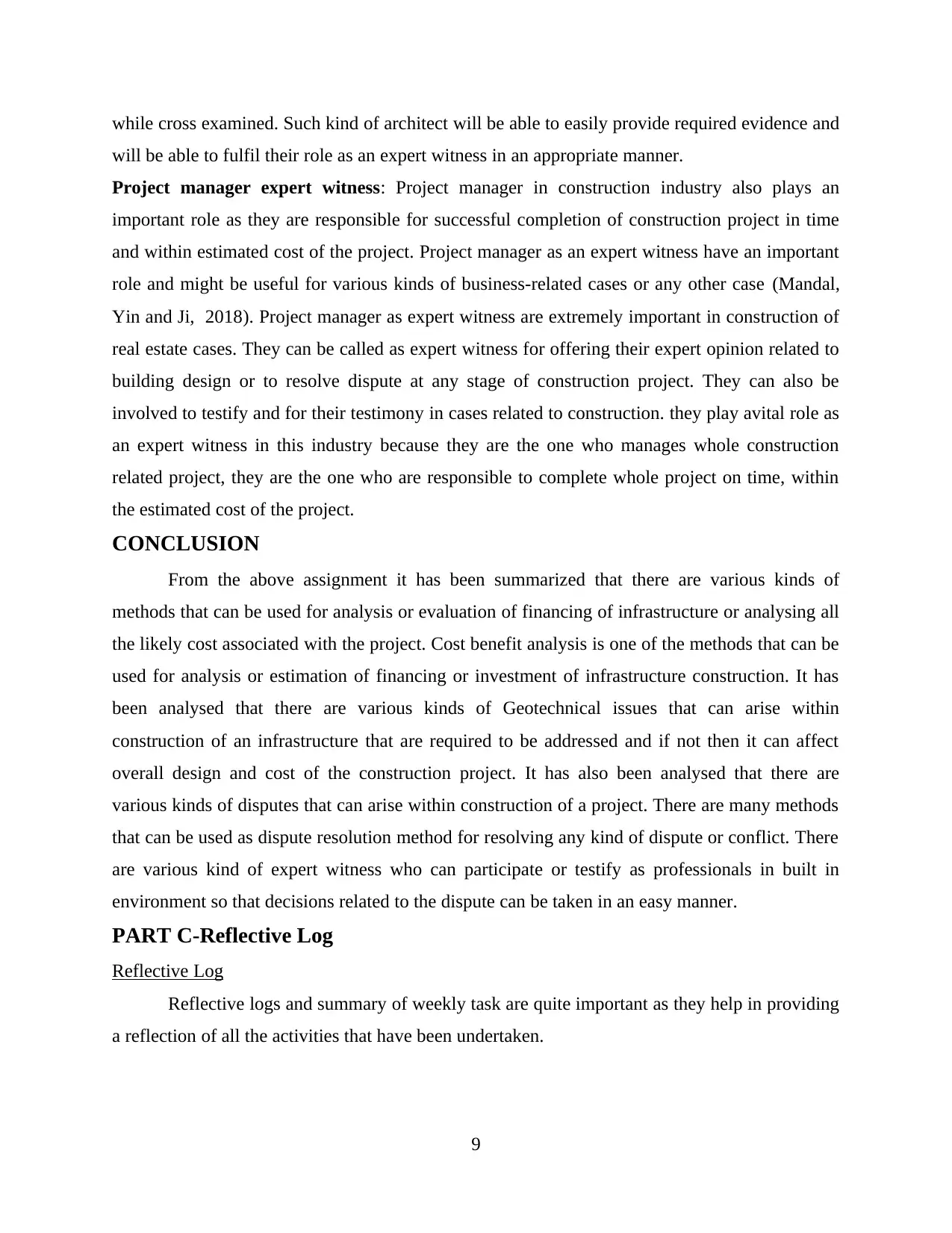
while cross examined. Such kind of architect will be able to easily provide required evidence and
will be able to fulfil their role as an expert witness in an appropriate manner.
Project manager expert witness: Project manager in construction industry also plays an
important role as they are responsible for successful completion of construction project in time
and within estimated cost of the project. Project manager as an expert witness have an important
role and might be useful for various kinds of business-related cases or any other case (Mandal,
Yin and Ji, 2018). Project manager as expert witness are extremely important in construction of
real estate cases. They can be called as expert witness for offering their expert opinion related to
building design or to resolve dispute at any stage of construction project. They can also be
involved to testify and for their testimony in cases related to construction. they play avital role as
an expert witness in this industry because they are the one who manages whole construction
related project, they are the one who are responsible to complete whole project on time, within
the estimated cost of the project.
CONCLUSION
From the above assignment it has been summarized that there are various kinds of
methods that can be used for analysis or evaluation of financing of infrastructure or analysing all
the likely cost associated with the project. Cost benefit analysis is one of the methods that can be
used for analysis or estimation of financing or investment of infrastructure construction. It has
been analysed that there are various kinds of Geotechnical issues that can arise within
construction of an infrastructure that are required to be addressed and if not then it can affect
overall design and cost of the construction project. It has also been analysed that there are
various kinds of disputes that can arise within construction of a project. There are many methods
that can be used as dispute resolution method for resolving any kind of dispute or conflict. There
are various kind of expert witness who can participate or testify as professionals in built in
environment so that decisions related to the dispute can be taken in an easy manner.
PART C-Reflective Log
Reflective Log
Reflective logs and summary of weekly task are quite important as they help in providing
a reflection of all the activities that have been undertaken.
9
will be able to fulfil their role as an expert witness in an appropriate manner.
Project manager expert witness: Project manager in construction industry also plays an
important role as they are responsible for successful completion of construction project in time
and within estimated cost of the project. Project manager as an expert witness have an important
role and might be useful for various kinds of business-related cases or any other case (Mandal,
Yin and Ji, 2018). Project manager as expert witness are extremely important in construction of
real estate cases. They can be called as expert witness for offering their expert opinion related to
building design or to resolve dispute at any stage of construction project. They can also be
involved to testify and for their testimony in cases related to construction. they play avital role as
an expert witness in this industry because they are the one who manages whole construction
related project, they are the one who are responsible to complete whole project on time, within
the estimated cost of the project.
CONCLUSION
From the above assignment it has been summarized that there are various kinds of
methods that can be used for analysis or evaluation of financing of infrastructure or analysing all
the likely cost associated with the project. Cost benefit analysis is one of the methods that can be
used for analysis or estimation of financing or investment of infrastructure construction. It has
been analysed that there are various kinds of Geotechnical issues that can arise within
construction of an infrastructure that are required to be addressed and if not then it can affect
overall design and cost of the construction project. It has also been analysed that there are
various kinds of disputes that can arise within construction of a project. There are many methods
that can be used as dispute resolution method for resolving any kind of dispute or conflict. There
are various kind of expert witness who can participate or testify as professionals in built in
environment so that decisions related to the dispute can be taken in an easy manner.
PART C-Reflective Log
Reflective Log
Reflective logs and summary of weekly task are quite important as they help in providing
a reflection of all the activities that have been undertaken.
9
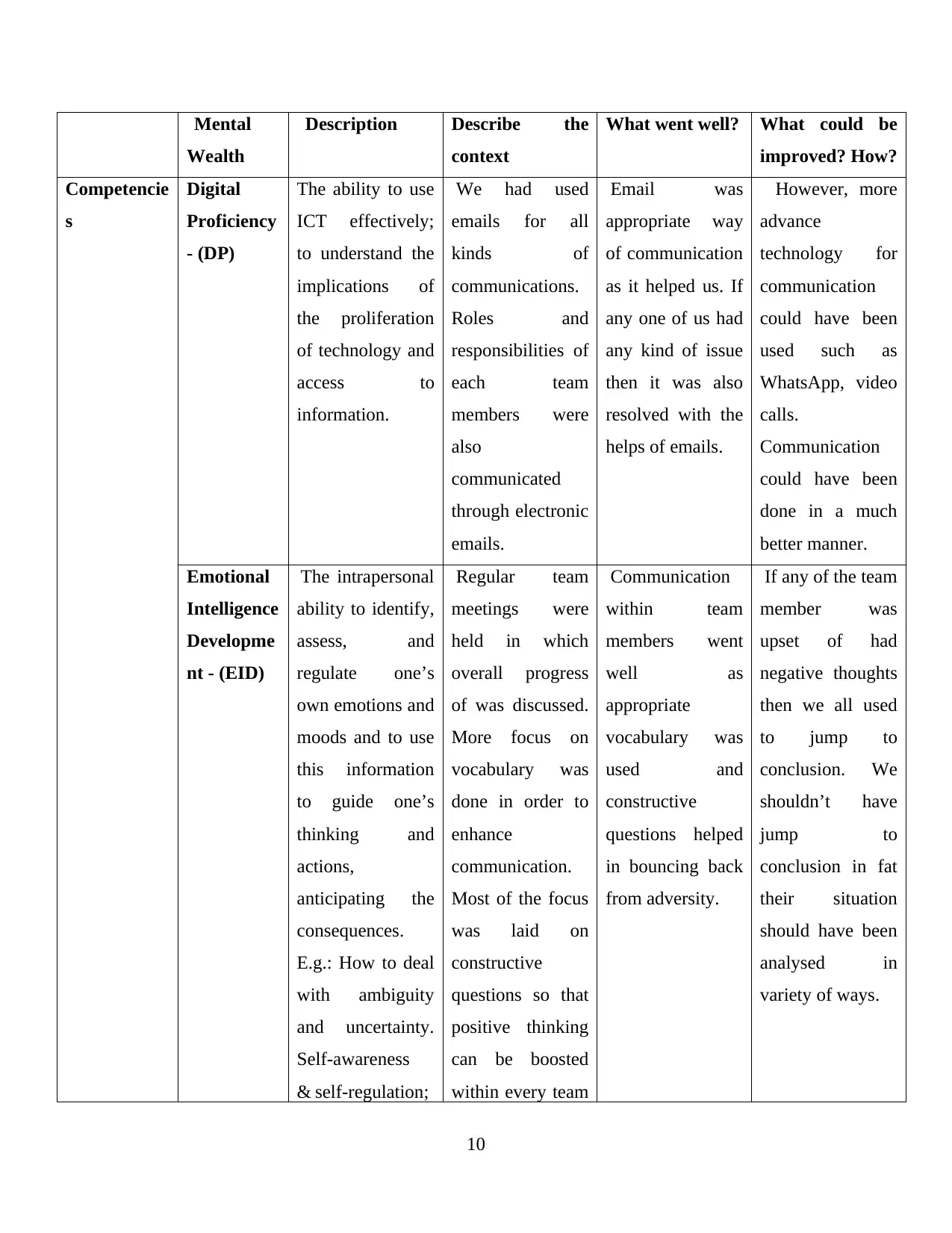
Mental
Wealth
Description Describe the
context
What went well? What could be
improved? How?
Competencie
s
Digital
Proficiency
- (DP)
The ability to use
ICT effectively;
to understand the
implications of
the proliferation
of technology and
access to
information.
We had used
emails for all
kinds of
communications.
Roles and
responsibilities of
each team
members were
also
communicated
through electronic
emails.
Email was
appropriate way
of communication
as it helped us. If
any one of us had
any kind of issue
then it was also
resolved with the
helps of emails.
However, more
advance
technology for
communication
could have been
used such as
WhatsApp, video
calls.
Communication
could have been
done in a much
better manner.
Emotional
Intelligence
Developme
nt - (EID)
The intrapersonal
ability to identify,
assess, and
regulate one’s
own emotions and
moods and to use
this information
to guide one’s
thinking and
actions,
anticipating the
consequences.
E.g.: How to deal
with ambiguity
and uncertainty.
Self-awareness
& self-regulation;
Regular team
meetings were
held in which
overall progress
of was discussed.
More focus on
vocabulary was
done in order to
enhance
communication.
Most of the focus
was laid on
constructive
questions so that
positive thinking
can be boosted
within every team
Communication
within team
members went
well as
appropriate
vocabulary was
used and
constructive
questions helped
in bouncing back
from adversity.
If any of the team
member was
upset of had
negative thoughts
then we all used
to jump to
conclusion. We
shouldn’t have
jump to
conclusion in fat
their situation
should have been
analysed in
variety of ways.
10
Wealth
Description Describe the
context
What went well? What could be
improved? How?
Competencie
s
Digital
Proficiency
- (DP)
The ability to use
ICT effectively;
to understand the
implications of
the proliferation
of technology and
access to
information.
We had used
emails for all
kinds of
communications.
Roles and
responsibilities of
each team
members were
also
communicated
through electronic
emails.
Email was
appropriate way
of communication
as it helped us. If
any one of us had
any kind of issue
then it was also
resolved with the
helps of emails.
However, more
advance
technology for
communication
could have been
used such as
WhatsApp, video
calls.
Communication
could have been
done in a much
better manner.
Emotional
Intelligence
Developme
nt - (EID)
The intrapersonal
ability to identify,
assess, and
regulate one’s
own emotions and
moods and to use
this information
to guide one’s
thinking and
actions,
anticipating the
consequences.
E.g.: How to deal
with ambiguity
and uncertainty.
Self-awareness
& self-regulation;
Regular team
meetings were
held in which
overall progress
of was discussed.
More focus on
vocabulary was
done in order to
enhance
communication.
Most of the focus
was laid on
constructive
questions so that
positive thinking
can be boosted
within every team
Communication
within team
members went
well as
appropriate
vocabulary was
used and
constructive
questions helped
in bouncing back
from adversity.
If any of the team
member was
upset of had
negative thoughts
then we all used
to jump to
conclusion. We
shouldn’t have
jump to
conclusion in fat
their situation
should have been
analysed in
variety of ways.
10
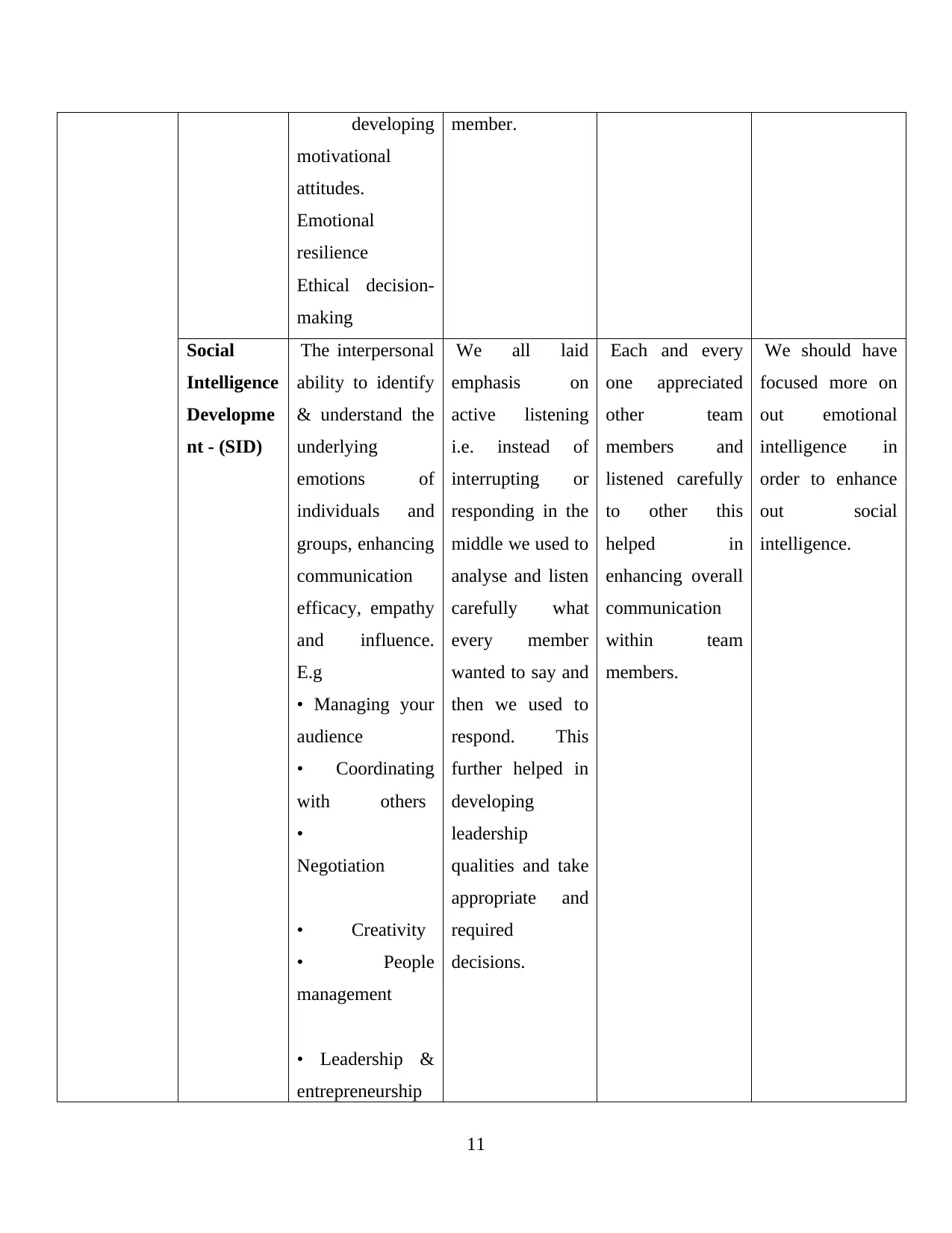
developing
motivational
attitudes.
Emotional
resilience
Ethical decision-
making
member.
Social
Intelligence
Developme
nt - (SID)
The interpersonal
ability to identify
& understand the
underlying
emotions of
individuals and
groups, enhancing
communication
efficacy, empathy
and influence.
E.g
• Managing your
audience
• Coordinating
with others
•
Negotiation
• Creativity
• People
management
• Leadership &
entrepreneurship
We all laid
emphasis on
active listening
i.e. instead of
interrupting or
responding in the
middle we used to
analyse and listen
carefully what
every member
wanted to say and
then we used to
respond. This
further helped in
developing
leadership
qualities and take
appropriate and
required
decisions.
Each and every
one appreciated
other team
members and
listened carefully
to other this
helped in
enhancing overall
communication
within team
members.
We should have
focused more on
out emotional
intelligence in
order to enhance
out social
intelligence.
11
motivational
attitudes.
Emotional
resilience
Ethical decision-
making
member.
Social
Intelligence
Developme
nt - (SID)
The interpersonal
ability to identify
& understand the
underlying
emotions of
individuals and
groups, enhancing
communication
efficacy, empathy
and influence.
E.g
• Managing your
audience
• Coordinating
with others
•
Negotiation
• Creativity
• People
management
• Leadership &
entrepreneurship
We all laid
emphasis on
active listening
i.e. instead of
interrupting or
responding in the
middle we used to
analyse and listen
carefully what
every member
wanted to say and
then we used to
respond. This
further helped in
developing
leadership
qualities and take
appropriate and
required
decisions.
Each and every
one appreciated
other team
members and
listened carefully
to other this
helped in
enhancing overall
communication
within team
members.
We should have
focused more on
out emotional
intelligence in
order to enhance
out social
intelligence.
11
Paraphrase This Document
Need a fresh take? Get an instant paraphrase of this document with our AI Paraphraser

• Service
orientation
• Active
listening
•Coaching &
mentoring
Physical
Intelligence
Developme
nt - (PID)
The ability to
perceive and
optimise your
responses to
influence your
emotion, and
effect your
behaviour. E.g.
• Self-discipline
& self-
management
• Attention span /
reaction &
response time
• Cognitive &
muscle memory
• Managing stress
& physical
resilience
I had developed a
personal
development plan
which helped me
in self-
management.
This PDP helped
me in
development of
time management
skills with the
help of which I
was able to
complete all the
task on time and
remain stress free.
In this we all
were able to
complete all out
task and
responsibilities in
a disciplined
manner
Response time of
all the team
members could
have been
improved as none
of the team
members were
able to respond to
any query on
time.
Cognitive
Intelligence
(CI)
The ability to
acquire, retain
and use
knowledge,
recognise, pose
In order to
understand
resolve any kind
of problem
brainstorming
Problems that
arise within team
were recognized
easily and with
the help of
In order to
enhance my
cognitive skills I
could have
attended
12
orientation
• Active
listening
•Coaching &
mentoring
Physical
Intelligence
Developme
nt - (PID)
The ability to
perceive and
optimise your
responses to
influence your
emotion, and
effect your
behaviour. E.g.
• Self-discipline
& self-
management
• Attention span /
reaction &
response time
• Cognitive &
muscle memory
• Managing stress
& physical
resilience
I had developed a
personal
development plan
which helped me
in self-
management.
This PDP helped
me in
development of
time management
skills with the
help of which I
was able to
complete all the
task on time and
remain stress free.
In this we all
were able to
complete all out
task and
responsibilities in
a disciplined
manner
Response time of
all the team
members could
have been
improved as none
of the team
members were
able to respond to
any query on
time.
Cognitive
Intelligence
(CI)
The ability to
acquire, retain
and use
knowledge,
recognise, pose
In order to
understand
resolve any kind
of problem
brainstorming
Problems that
arise within team
were recognized
easily and with
the help of
In order to
enhance my
cognitive skills I
could have
attended
12
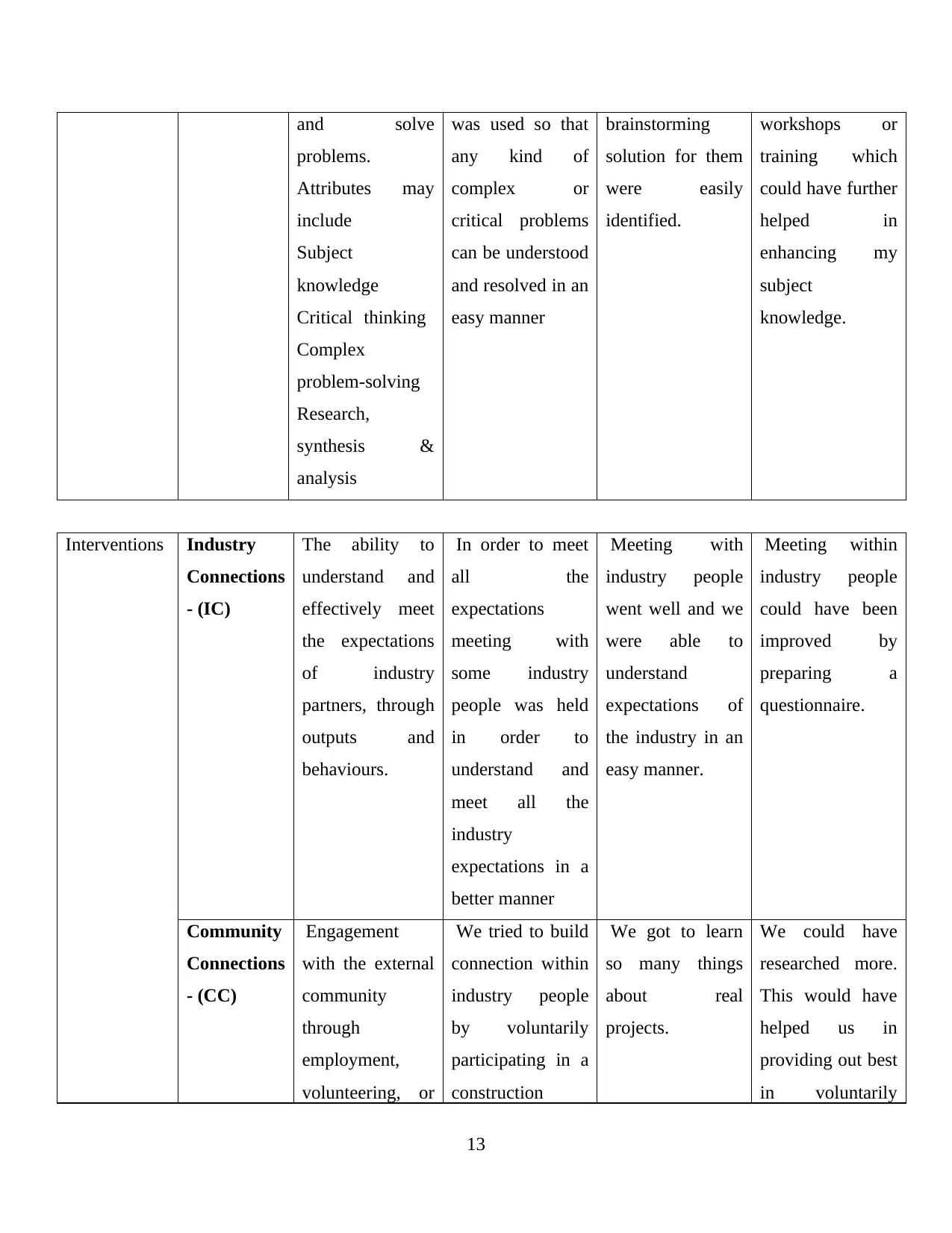
and solve
problems.
Attributes may
include
Subject
knowledge
Critical thinking
Complex
problem-solving
Research,
synthesis &
analysis
was used so that
any kind of
complex or
critical problems
can be understood
and resolved in an
easy manner
brainstorming
solution for them
were easily
identified.
workshops or
training which
could have further
helped in
enhancing my
subject
knowledge.
Interventions Industry
Connections
- (IC)
The ability to
understand and
effectively meet
the expectations
of industry
partners, through
outputs and
behaviours.
In order to meet
all the
expectations
meeting with
some industry
people was held
in order to
understand and
meet all the
industry
expectations in a
better manner
Meeting with
industry people
went well and we
were able to
understand
expectations of
the industry in an
easy manner.
Meeting within
industry people
could have been
improved by
preparing a
questionnaire.
Community
Connections
- (CC)
Engagement
with the external
community
through
employment,
volunteering, or
We tried to build
connection within
industry people
by voluntarily
participating in a
construction
We got to learn
so many things
about real
projects.
We could have
researched more.
This would have
helped us in
providing out best
in voluntarily
13
problems.
Attributes may
include
Subject
knowledge
Critical thinking
Complex
problem-solving
Research,
synthesis &
analysis
was used so that
any kind of
complex or
critical problems
can be understood
and resolved in an
easy manner
brainstorming
solution for them
were easily
identified.
workshops or
training which
could have further
helped in
enhancing my
subject
knowledge.
Interventions Industry
Connections
- (IC)
The ability to
understand and
effectively meet
the expectations
of industry
partners, through
outputs and
behaviours.
In order to meet
all the
expectations
meeting with
some industry
people was held
in order to
understand and
meet all the
industry
expectations in a
better manner
Meeting with
industry people
went well and we
were able to
understand
expectations of
the industry in an
easy manner.
Meeting within
industry people
could have been
improved by
preparing a
questionnaire.
Community
Connections
- (CC)
Engagement
with the external
community
through
employment,
volunteering, or
We tried to build
connection within
industry people
by voluntarily
participating in a
construction
We got to learn
so many things
about real
projects.
We could have
researched more.
This would have
helped us in
providing out best
in voluntarily
13
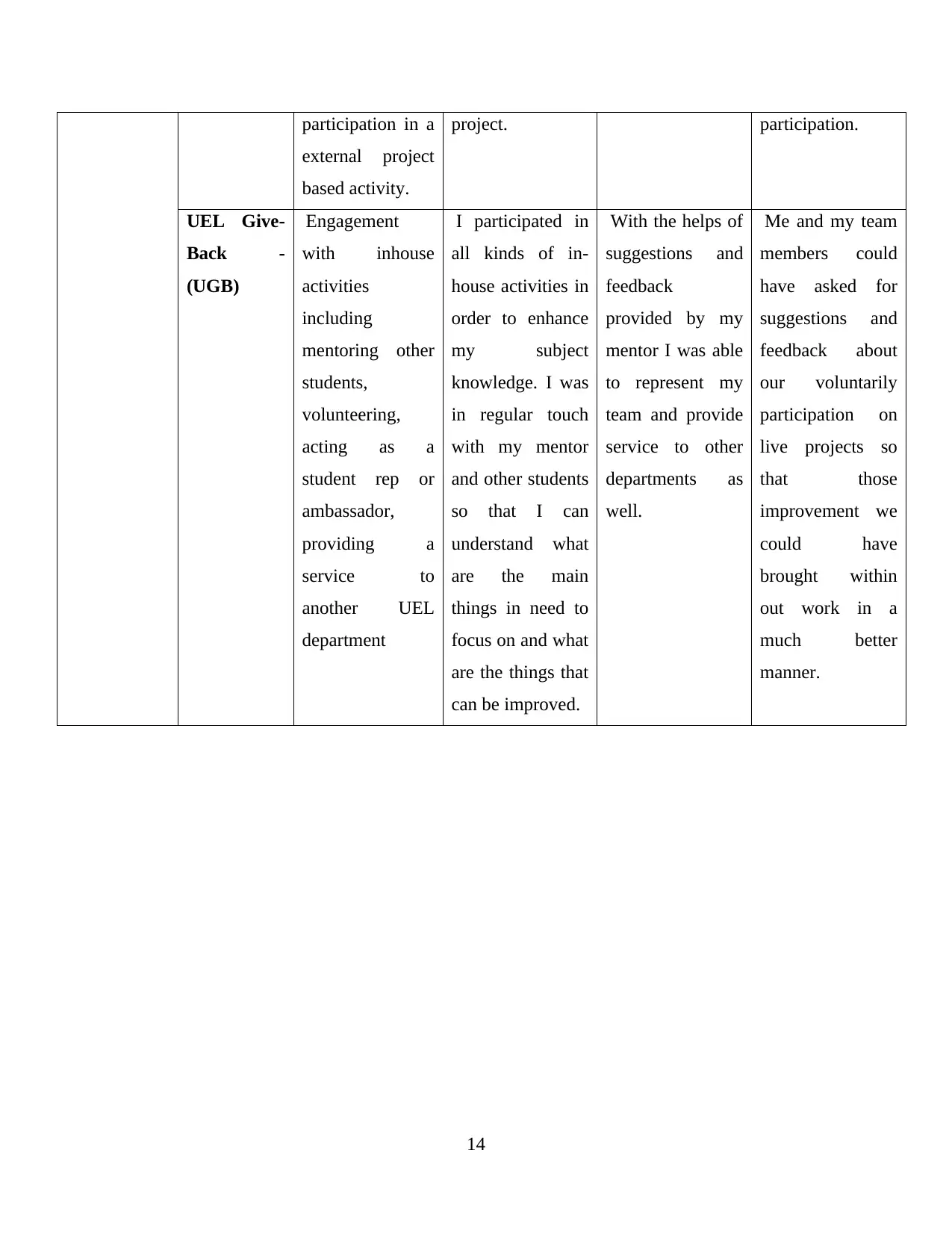
participation in a
external project
based activity.
project. participation.
UEL Give-
Back -
(UGB)
Engagement
with inhouse
activities
including
mentoring other
students,
volunteering,
acting as a
student rep or
ambassador,
providing a
service to
another UEL
department
I participated in
all kinds of in-
house activities in
order to enhance
my subject
knowledge. I was
in regular touch
with my mentor
and other students
so that I can
understand what
are the main
things in need to
focus on and what
are the things that
can be improved.
With the helps of
suggestions and
feedback
provided by my
mentor I was able
to represent my
team and provide
service to other
departments as
well.
Me and my team
members could
have asked for
suggestions and
feedback about
our voluntarily
participation on
live projects so
that those
improvement we
could have
brought within
out work in a
much better
manner.
14
external project
based activity.
project. participation.
UEL Give-
Back -
(UGB)
Engagement
with inhouse
activities
including
mentoring other
students,
volunteering,
acting as a
student rep or
ambassador,
providing a
service to
another UEL
department
I participated in
all kinds of in-
house activities in
order to enhance
my subject
knowledge. I was
in regular touch
with my mentor
and other students
so that I can
understand what
are the main
things in need to
focus on and what
are the things that
can be improved.
With the helps of
suggestions and
feedback
provided by my
mentor I was able
to represent my
team and provide
service to other
departments as
well.
Me and my team
members could
have asked for
suggestions and
feedback about
our voluntarily
participation on
live projects so
that those
improvement we
could have
brought within
out work in a
much better
manner.
14
Secure Best Marks with AI Grader
Need help grading? Try our AI Grader for instant feedback on your assignments.
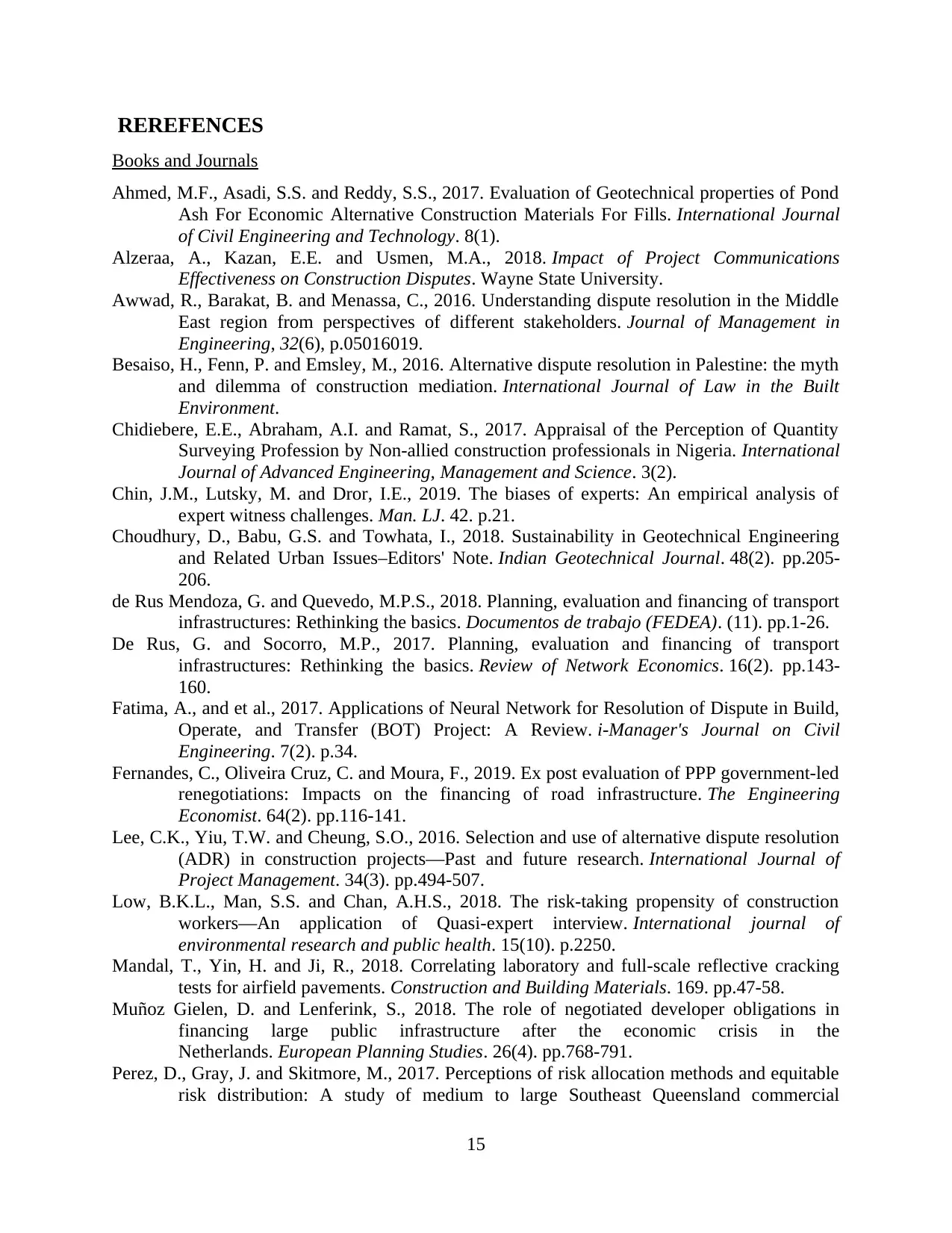
REREFENCES
Books and Journals
Ahmed, M.F., Asadi, S.S. and Reddy, S.S., 2017. Evaluation of Geotechnical properties of Pond
Ash For Economic Alternative Construction Materials For Fills. International Journal
of Civil Engineering and Technology. 8(1).
Alzeraa, A., Kazan, E.E. and Usmen, M.A., 2018. Impact of Project Communications
Effectiveness on Construction Disputes. Wayne State University.
Awwad, R., Barakat, B. and Menassa, C., 2016. Understanding dispute resolution in the Middle
East region from perspectives of different stakeholders. Journal of Management in
Engineering, 32(6), p.05016019.
Besaiso, H., Fenn, P. and Emsley, M., 2016. Alternative dispute resolution in Palestine: the myth
and dilemma of construction mediation. International Journal of Law in the Built
Environment.
Chidiebere, E.E., Abraham, A.I. and Ramat, S., 2017. Appraisal of the Perception of Quantity
Surveying Profession by Non-allied construction professionals in Nigeria. International
Journal of Advanced Engineering, Management and Science. 3(2).
Chin, J.M., Lutsky, M. and Dror, I.E., 2019. The biases of experts: An empirical analysis of
expert witness challenges. Man. LJ. 42. p.21.
Choudhury, D., Babu, G.S. and Towhata, I., 2018. Sustainability in Geotechnical Engineering
and Related Urban Issues–Editors' Note. Indian Geotechnical Journal. 48(2). pp.205-
206.
de Rus Mendoza, G. and Quevedo, M.P.S., 2018. Planning, evaluation and financing of transport
infrastructures: Rethinking the basics. Documentos de trabajo (FEDEA). (11). pp.1-26.
De Rus, G. and Socorro, M.P., 2017. Planning, evaluation and financing of transport
infrastructures: Rethinking the basics. Review of Network Economics. 16(2). pp.143-
160.
Fatima, A., and et al., 2017. Applications of Neural Network for Resolution of Dispute in Build,
Operate, and Transfer (BOT) Project: A Review. i-Manager's Journal on Civil
Engineering. 7(2). p.34.
Fernandes, C., Oliveira Cruz, C. and Moura, F., 2019. Ex post evaluation of PPP government-led
renegotiations: Impacts on the financing of road infrastructure. The Engineering
Economist. 64(2). pp.116-141.
Lee, C.K., Yiu, T.W. and Cheung, S.O., 2016. Selection and use of alternative dispute resolution
(ADR) in construction projects—Past and future research. International Journal of
Project Management. 34(3). pp.494-507.
Low, B.K.L., Man, S.S. and Chan, A.H.S., 2018. The risk-taking propensity of construction
workers—An application of Quasi-expert interview. International journal of
environmental research and public health. 15(10). p.2250.
Mandal, T., Yin, H. and Ji, R., 2018. Correlating laboratory and full-scale reflective cracking
tests for airfield pavements. Construction and Building Materials. 169. pp.47-58.
Muñoz Gielen, D. and Lenferink, S., 2018. The role of negotiated developer obligations in
financing large public infrastructure after the economic crisis in the
Netherlands. European Planning Studies. 26(4). pp.768-791.
Perez, D., Gray, J. and Skitmore, M., 2017. Perceptions of risk allocation methods and equitable
risk distribution: A study of medium to large Southeast Queensland commercial
15
Books and Journals
Ahmed, M.F., Asadi, S.S. and Reddy, S.S., 2017. Evaluation of Geotechnical properties of Pond
Ash For Economic Alternative Construction Materials For Fills. International Journal
of Civil Engineering and Technology. 8(1).
Alzeraa, A., Kazan, E.E. and Usmen, M.A., 2018. Impact of Project Communications
Effectiveness on Construction Disputes. Wayne State University.
Awwad, R., Barakat, B. and Menassa, C., 2016. Understanding dispute resolution in the Middle
East region from perspectives of different stakeholders. Journal of Management in
Engineering, 32(6), p.05016019.
Besaiso, H., Fenn, P. and Emsley, M., 2016. Alternative dispute resolution in Palestine: the myth
and dilemma of construction mediation. International Journal of Law in the Built
Environment.
Chidiebere, E.E., Abraham, A.I. and Ramat, S., 2017. Appraisal of the Perception of Quantity
Surveying Profession by Non-allied construction professionals in Nigeria. International
Journal of Advanced Engineering, Management and Science. 3(2).
Chin, J.M., Lutsky, M. and Dror, I.E., 2019. The biases of experts: An empirical analysis of
expert witness challenges. Man. LJ. 42. p.21.
Choudhury, D., Babu, G.S. and Towhata, I., 2018. Sustainability in Geotechnical Engineering
and Related Urban Issues–Editors' Note. Indian Geotechnical Journal. 48(2). pp.205-
206.
de Rus Mendoza, G. and Quevedo, M.P.S., 2018. Planning, evaluation and financing of transport
infrastructures: Rethinking the basics. Documentos de trabajo (FEDEA). (11). pp.1-26.
De Rus, G. and Socorro, M.P., 2017. Planning, evaluation and financing of transport
infrastructures: Rethinking the basics. Review of Network Economics. 16(2). pp.143-
160.
Fatima, A., and et al., 2017. Applications of Neural Network for Resolution of Dispute in Build,
Operate, and Transfer (BOT) Project: A Review. i-Manager's Journal on Civil
Engineering. 7(2). p.34.
Fernandes, C., Oliveira Cruz, C. and Moura, F., 2019. Ex post evaluation of PPP government-led
renegotiations: Impacts on the financing of road infrastructure. The Engineering
Economist. 64(2). pp.116-141.
Lee, C.K., Yiu, T.W. and Cheung, S.O., 2016. Selection and use of alternative dispute resolution
(ADR) in construction projects—Past and future research. International Journal of
Project Management. 34(3). pp.494-507.
Low, B.K.L., Man, S.S. and Chan, A.H.S., 2018. The risk-taking propensity of construction
workers—An application of Quasi-expert interview. International journal of
environmental research and public health. 15(10). p.2250.
Mandal, T., Yin, H. and Ji, R., 2018. Correlating laboratory and full-scale reflective cracking
tests for airfield pavements. Construction and Building Materials. 169. pp.47-58.
Muñoz Gielen, D. and Lenferink, S., 2018. The role of negotiated developer obligations in
financing large public infrastructure after the economic crisis in the
Netherlands. European Planning Studies. 26(4). pp.768-791.
Perez, D., Gray, J. and Skitmore, M., 2017. Perceptions of risk allocation methods and equitable
risk distribution: A study of medium to large Southeast Queensland commercial
15
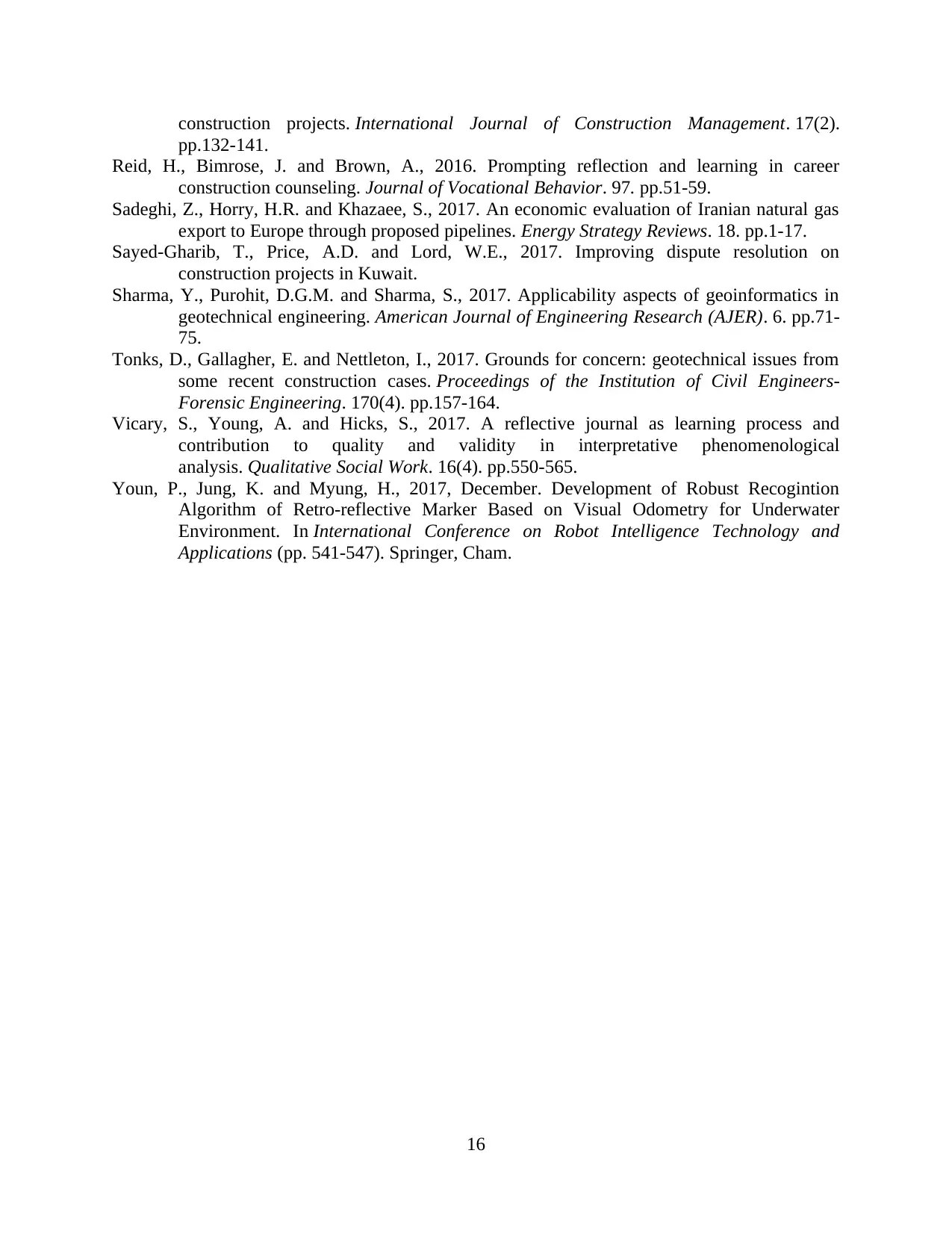
construction projects. International Journal of Construction Management. 17(2).
pp.132-141.
Reid, H., Bimrose, J. and Brown, A., 2016. Prompting reflection and learning in career
construction counseling. Journal of Vocational Behavior. 97. pp.51-59.
Sadeghi, Z., Horry, H.R. and Khazaee, S., 2017. An economic evaluation of Iranian natural gas
export to Europe through proposed pipelines. Energy Strategy Reviews. 18. pp.1-17.
Sayed-Gharib, T., Price, A.D. and Lord, W.E., 2017. Improving dispute resolution on
construction projects in Kuwait.
Sharma, Y., Purohit, D.G.M. and Sharma, S., 2017. Applicability aspects of geoinformatics in
geotechnical engineering. American Journal of Engineering Research (AJER). 6. pp.71-
75.
Tonks, D., Gallagher, E. and Nettleton, I., 2017. Grounds for concern: geotechnical issues from
some recent construction cases. Proceedings of the Institution of Civil Engineers-
Forensic Engineering. 170(4). pp.157-164.
Vicary, S., Young, A. and Hicks, S., 2017. A reflective journal as learning process and
contribution to quality and validity in interpretative phenomenological
analysis. Qualitative Social Work. 16(4). pp.550-565.
Youn, P., Jung, K. and Myung, H., 2017, December. Development of Robust Recogintion
Algorithm of Retro-reflective Marker Based on Visual Odometry for Underwater
Environment. In International Conference on Robot Intelligence Technology and
Applications (pp. 541-547). Springer, Cham.
16
pp.132-141.
Reid, H., Bimrose, J. and Brown, A., 2016. Prompting reflection and learning in career
construction counseling. Journal of Vocational Behavior. 97. pp.51-59.
Sadeghi, Z., Horry, H.R. and Khazaee, S., 2017. An economic evaluation of Iranian natural gas
export to Europe through proposed pipelines. Energy Strategy Reviews. 18. pp.1-17.
Sayed-Gharib, T., Price, A.D. and Lord, W.E., 2017. Improving dispute resolution on
construction projects in Kuwait.
Sharma, Y., Purohit, D.G.M. and Sharma, S., 2017. Applicability aspects of geoinformatics in
geotechnical engineering. American Journal of Engineering Research (AJER). 6. pp.71-
75.
Tonks, D., Gallagher, E. and Nettleton, I., 2017. Grounds for concern: geotechnical issues from
some recent construction cases. Proceedings of the Institution of Civil Engineers-
Forensic Engineering. 170(4). pp.157-164.
Vicary, S., Young, A. and Hicks, S., 2017. A reflective journal as learning process and
contribution to quality and validity in interpretative phenomenological
analysis. Qualitative Social Work. 16(4). pp.550-565.
Youn, P., Jung, K. and Myung, H., 2017, December. Development of Robust Recogintion
Algorithm of Retro-reflective Marker Based on Visual Odometry for Underwater
Environment. In International Conference on Robot Intelligence Technology and
Applications (pp. 541-547). Springer, Cham.
16
1 out of 18
Your All-in-One AI-Powered Toolkit for Academic Success.
+13062052269
info@desklib.com
Available 24*7 on WhatsApp / Email
![[object Object]](/_next/static/media/star-bottom.7253800d.svg)
Unlock your academic potential
© 2024 | Zucol Services PVT LTD | All rights reserved.

